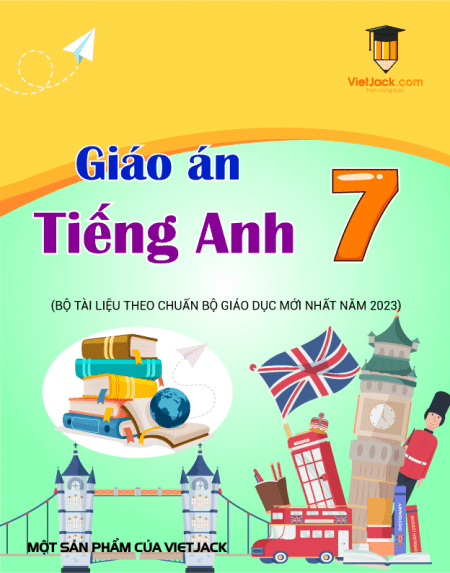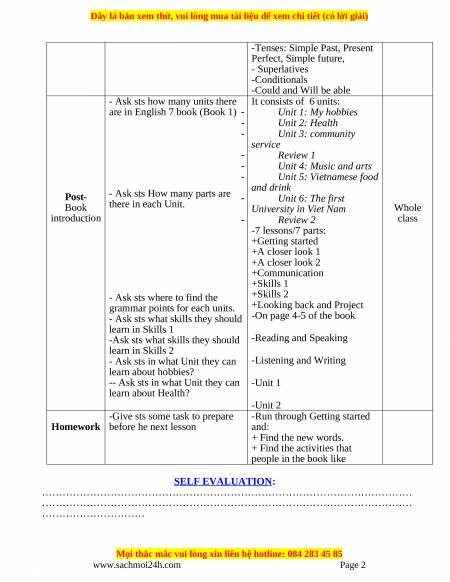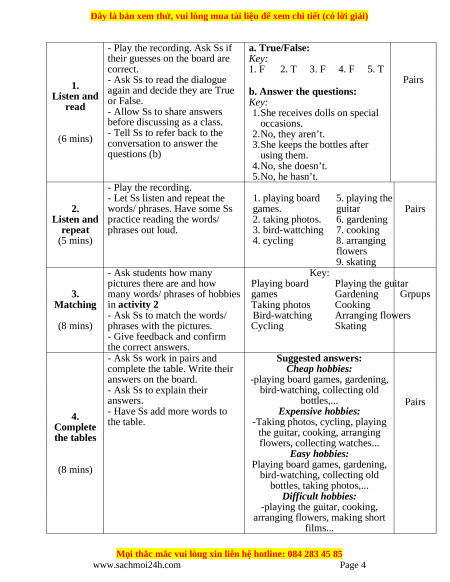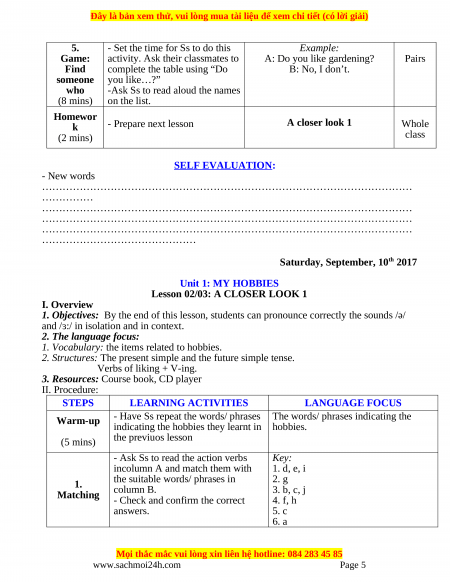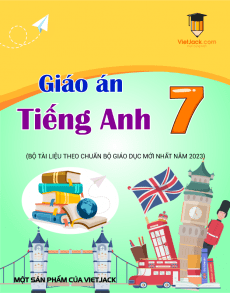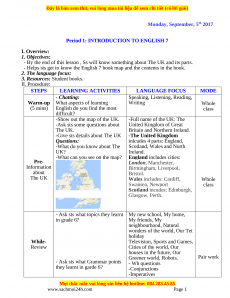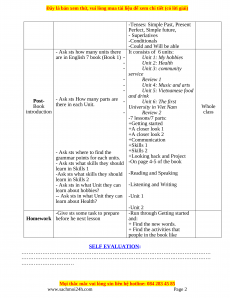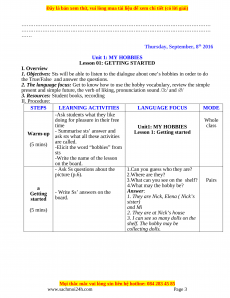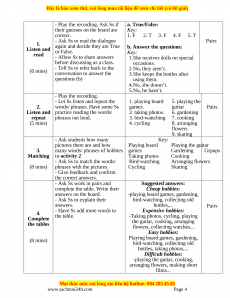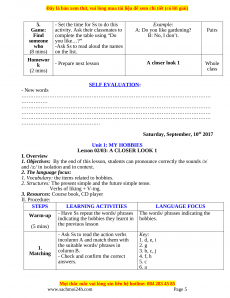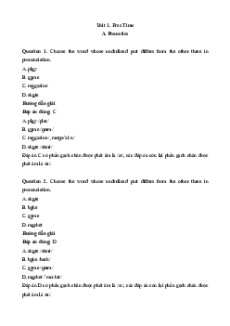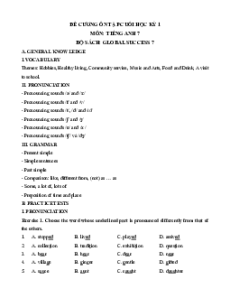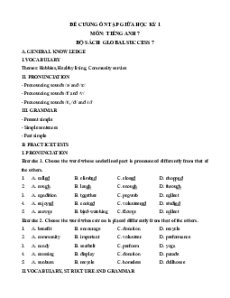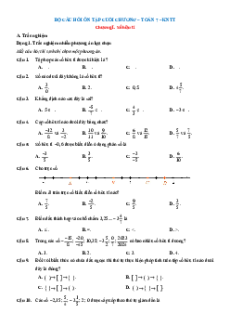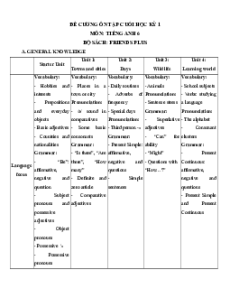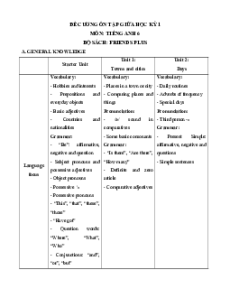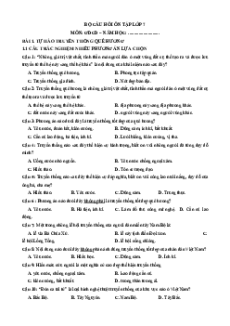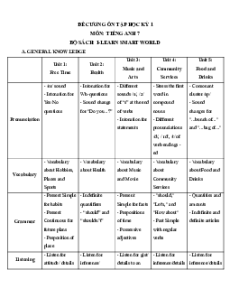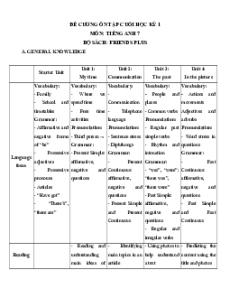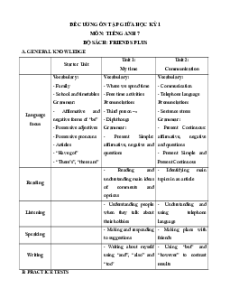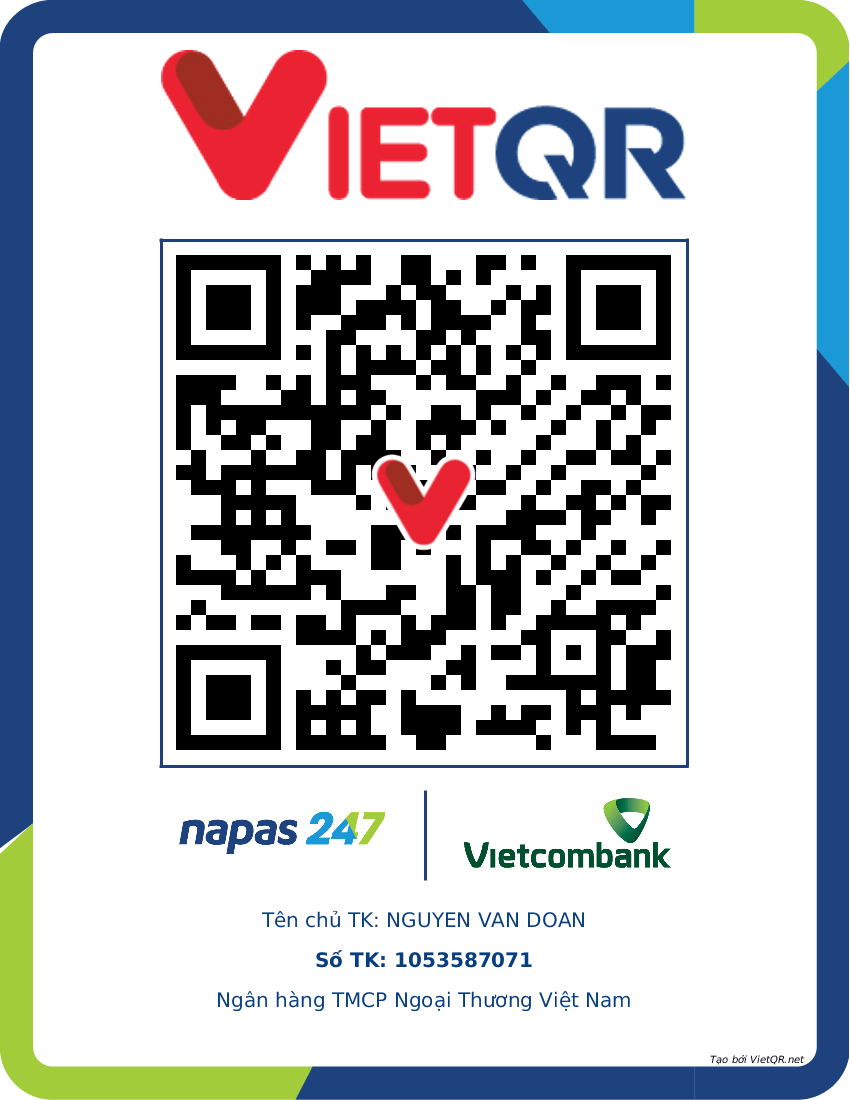Monday, September, 5th 2017
Period 1: INTRODUCTION TO ENGLISH 7 I. Overview: 1. Objectives:
- By the end of this lesson , Ss will know something about The UK and its parts.
- Helps sts get to know the English 7 book map and the contents in the book.
2. The language focus:
3. Resources: Student books. II. Procedure: STEPS LEARNING ACTIVITIES LANGUAGE FOCUS MODE - Chatting: Speaking, Listening, Reading,
Warm-up What aspects of learning Writing Whole (5 mins) English do you find the most class difficult? -Show out the map of the UK. -Full name of the UK: The -Ask sts some questions about United Kingdom of Great The UK. Britain and Northern Ireland. -Give sts details about The UK -The United Kingdom Questions: inlcudes 4 parts: England, -What do you know about The Scotland, Wales and North UK? Ireland. -What can you see on the map?
England includes cities: Pre-
London, Manchester, Information Birmingham, Liverpool, about Bristol. The UK
Wales includes: Cardiff, Whole Swansea, Newport class
Scotland incudes: Edinburgh, Glasgow, Perth.
- Ask sts what topics they learnt My new school, My home, in grade 6? My friends, My neighbourhood, Natural wonders of the world, Our Tet holiday While- Television, Sports and Games, Review Cities of the world, Our houses in the future, Our Greener world, Robots. Pair work - Ask sts what Grammar points - Wh questions they learnt in garde 6? -Conjunctions -Imperatives
www.sachmoi24h.com Page 1
-Tenses: Simple Past, Present Perfect, Simple future, - Superlatives -Conditionals -Could and Will be able
- Ask sts how many units there It consists of 6 units:
are in English 7 book (Book 1) - Unit 1: My hobbies - Unit 2: Health - Unit 3: community service - Review 1 - Unit 4: Music and arts - Unit 5: Vietnamese food and drink Post- - Ask sts How many parts are - Unit 6: The first Book there in each Unit. University in Viet Nam Whole introduction - Review 2 class -7 lessons/7 parts: +Getting started +A closer look 1 +A closer look 2 +Communication +Skills 1 - Ask sts where to find the +Skills 2 grammar points for each units. +Looking back and Project
- Ask sts what skills they should -On page 4-5 of the book learn in Skills 1
-Ask sts what skills they should -Reading and Speaking learn in Skills 2
- Ask sts in what Unit they can -Listening and Writing learn about hobbies?
-- Ask sts in what Unit they can -Unit 1 learn about Health? -Unit 2
-Give sts some task to prepare -Run through Getting started
Homework before he next lesson and: + Find the new words. + Find the activities that people in the book like SELF EVALUATION:
………………………………………………………………………………………………
……………………………………………………………………………………………… …………………………
www.sachmoi24h.com Page 2
………………………………………………………………………………………………
……………………………………………………………………………………………… ……
Thursday, September, 8th 2016 Unit 1: MY HOBBIES
Lesson 01: GETTING STARTED I. Overview
1. Objectives: Sts will be able to listen to the dialogue about one’s hobbies in order to do
the True/False and answer the questions.
2. The language focus: Get to know how to use the hobby vocabulary, review the simple
present and simple future, the verb of liking, pronunciation sound /3:/ and /∂/
3. Resources: Student books, recording II. Procedure: STEPS LEARNING ACTIVITIES LANGUAGE FOCUS MODE -Ask students what they like
doing for pleasure in their free Whole time Unit1: MY HOBBIES class
Warm-up - Summarise sts’ answer and
Lesson 1: Getting started
ask sts what all these activities (5 mins) are called.
-Elicit the word “hobbies” from sts -Write the name of the lesson on the board. - Ask Ss questions about the 1.Can you guess who they are? picture (p.6). 2.Where are they?
3.What can you see on the shelf? Pairs a 4.What may the hobby be? Getting - Write Ss’ answers on the Answer: started board.
1. They are Nick, Elena ( Nick’s sister) (5 mins) and Mi
2. They are at Nick’s house
3. I can see so many dolls on the
shelf. The hobby may be collecting dolls.
www.sachmoi24h.com Page 3
- Play the recording. Ask Ss if a. True/False:
their guesses on the board are Key: correct. 1. F 2. T 3. F 4. F 5. T - Ask Ss to read the dialogue Pairs 1.
again and decide they are True Listen and
b. Answer the questions: or False. read Key: - Allow Ss to share answers
1.She receives dolls on special before discussing as a class. occasions.
- Tell Ss to refer back to the (6 mins) 2.No, they aren’t. conversation to answer the 3.She keeps the bottles after questions (b) using them. 4.No, she doesn’t. 5.No, he hasn’t. - Play the recording.
- Let Ss listen and repeat the 1. playing board 5. playing the 2. words/ phrases. Have some Ss games. guitar Pairs
Listen and practice reading the words/ 2. taking photos. 6. gardening repeat phrases out loud. 3. bird-wattching 7. cooking (5 mins) 4. cycling 8. arranging flowers 9. skating - Ask students how many Key: pictures there are and how Playing board Playing the guitar 3.
many words/ phrases of hobbies games Gardening Grpups
Matching in activity 2 Taking photos Cooking - Ask Ss to match the words/ Bird-watching Arranging flowers (8 mins) phrases with the pictures. Cycling Skating - Give feedback and confirm the correct answers. - Ask Ss work in pairs and Suggested answers:
complete the table. Write their Cheap hobbies: answers on the board.
-playing board games, gardening, - Ask Ss to explain their bird-watching, collecting old answers. bottles,... Pairs 4. - Have Ss add more words to
Expensive hobbies: Complete the table.
-Taking photos, cycling, playing the tables the guitar, cooking, arranging flowers, collecting watches... Easy hobbies: (8 mins)
Playing board games, gardening, bird-watching, collecting old bottles, taking photos,...
Difficult hobbies: -playing the guitar, cooking,
arranging flowers, making short films...
www.sachmoi24h.com Page 4
Document Outline
- 2. Listen to the radio show about health fact or myths and check your answers in 1
- 3.Discuss the following in groups
- 4. Think of some sentences about health that are true and some are false
- Possible answer :
- True : -We shouldn't quit our break fast because it is very important
- False : Women after bearing don't take a bath for along time
- E.g:1. I find making pottery boring because we have to sit still and make things by hands.
- 2. I think dancing is interesting because you can enjoy lovely melody of the music you like while you are dancing.
- - Elicit the topic from students
- - Teacher model
- - Ss add as many activities as possible.
- - Teacher monitors and gets feedback.
- - Teacher follows the seven steps of teaching vocab
- - Use different techniques to teach.
- Check vocabulary: What and where.
- * Set the scene:
- - Make some questions
- - T collects the answers (guess)
- - calorie
- (n)
- ca lo
- - amount
- (adj)
- lượng
- - energy
- (adj)
- năng lượng
- -chart
- (n)
- bảng biểu
- Pre-questions
- You are going to read the text about the calories.?
- What do we get calories from?
- - Ask ss to open the book page 40, read the texts in silent and check their guessing.
- - T asks ss to work in pairs to do this activity
- - Go and check
- - Elicit answers from sts
- Key:
- Key:
- 1-B, 2-A, 3-C
- - Ask ss to read the text again then work in pairs to do this exercise.Ss may use their dictionaries
- - Get sts’ ideas.
- -Correct them
- 2.Find the words / phrases in the text. Discuss the meaning then check the meaning
- Key:
- (Teacher book, page: 22)
- - Ask ss to work pairs to answer the questions
- - Let them share their answer with partner
- - Call on 2 ss to write the answers on the board
- - T confirms the correct answers
- 5. People listen to his advice because he is an expert
- -Ask ss to look at the table and T explains the table
- - T asks ss to work in pairs to discuss the activity and the calories by answering 4 questions
- - T walks around to monitor
- 4.Discussion the following questions.
- -Ask ss to look at the chart and T explains the chart
- - Ask ss to work individually this activity
- . Complete the chart
- Activity
- Number of hours(per day)
- Total number of calories
- Running
- 2
- .............
- .............
- ................
- - Ask some ss to come to the front of the class to present
- - Guide ss how to do ex C1,P13, D3 P 15(Workbook)
- - Prepare next lesson.
- Unit 2. Lesson 6 Skills 2
- - Elicit the topic from students
- - Teacher model
- - Ss add as many activities as possible.
- - Teacher monitors and gets feedback.
- Teacher follows the seven steps of teaching vocab
- - Use different techniques to teach.
- -Check vocabulary: What and where
- triathlon
- (n)
- TT thi đấu 3 môn phối hợp
- maintain
- (v)
- duy trì
- count
- (v)
- tính toán
- pattern
- (n)
- mẫu
- itchy
- (a)
- Ngứa
- tough
- (a)
- dai
- burgers
- (n)
- sandwiches
- rest
- (n)
- nghỉ ngơi
- 1.1. Discuss the questions
- - Go through the questions
- - T asks ss to work in pairs to discuss them
- 1. Discuss the questions
- -Work in pairs to discuss the questions
- - Go through the questions
- - Play the recording twice and ask ss to circle the problems they hear
- - Ask ss to compare the answers with a partner
- - Give feedback and confirm the correct answer
- 2 . Listen the the interview. Which problems did he have as a child?
- - Listen to the recording and circle the problems
- Key :
- sick, allergy
- - Go through the phrases in the box
- - Ask ss to listen to the recording again and choose the right response
- - Ask ss to compare the answers with a partner
- - Give feedback and confirm the correct answer
- 3.Listen the the interview again . What advice does he give about preparing for event ?
- - Listen to the recording again and choose the right response
- - Go through 5 sentences
- - Ask to listen to the recording then choose the true/ false sentences
- -Ask ss to compare the answers with a partner
- - Ask 1 student to write his/he answer on th board
- 4 .Are the following sentences true of false ?
- -Listen to the recording then choose the true/ false sentences
- - Go through the questions .
- - T divides the class in to groups and give them 5 minutes to do it
- - Check and correct
- * Set the sence: You are going to listen to an interview of A 4!Teen reporter about Mi's hobbies.
- ? Run through all the information in 1-6
- ? Listen and fill in the gaps then compare with your partner.
- -Read the the questions and the advice then match
- - Work in pairs to write the health problem and the response
- 6.Match the problems with the answers
- Key:
- 1-c, 2-b, 3-a
- 7.Underline the ways Dr Dan gives the advice
- - Key :
- You should...
- You can .......
- It will be good if you......
- Do st more/ less ........
- - Guide ss how to do E D1,23 P15 (Workbook)
- - Prepare next lesson. Unit 2. Lesson 7: Looking back
- - Remember
- - Listen and take note the assignments
- - T divides the students into two teams
- - Call on one student to come to the front of the class read sentence by sentence in 1 and use gesture to express in 5 mins.
- - The members in two teams must go to the board and write the health problems.
- - T teams with more and correct health problems is the winner
- 1. What the health problems do you think each of the people has?
- - Take part in the game
- Key : a. sunburn
- b. spot
- c. put on weight
- d. stomachache
- e. flu
- - T asks ss to work individually to write the health problem in each pictures
- - Teacher checks and confirms the correct answers.
- 2. Look at the pictures. Write the health problem below each person
- Key:
- 1. sunburn
- 2. putting on weight
- 3. sunburn
- 4. sick/ stomachache
- 5. flu
- - T lets ss recall about imperative with less and more.
- -Recall about imperative with less and more and do the exercise in pairs
- - Ask them to do the exercise individually
- - Give feedback and confirm the correct answers
- 3.Complete the health tips below:
- - T has ss to recall about the compound sentences
- -Ask sts to recall about the compound sentences and do this activity in pairs
- - Ask some ss to read aloud the compound sentences
- - T confirms the correct answers
- 4. I can exercise every morning , or I can cycle to school
- - T shows ss who they are
- ( patients or doctors)
- - Go through the phrases in the box and the example interview
- -Model with one student
- - Reminds ss to use language for advice
- - Ask ss to practice in pairs
- - Call on some pairs to come to front of the class and interview
- - Vote the best interview
- Language for advice:
- You should........
- You can.......
- It will be good if you.........
- Do something more/less.......
- 5. Role -play a discussion.
- - T makes sure that ss know how to do this activity
- - Go through the example
- Note: To express your response about one opinion , you can use..
- - T asks ss to work in the pairs
- - Call on some pairs to practice
- 6. Discuss the following sentences about health with a partner. Do you think they are facts or myths?)
- Yes, I agree/ No, I disagree/ I don't thick it is......
- - Guide ss how to do the project : Do a survey about people’s health
- - Complete the project of Unit 2
- - Prepare next lesson:
- Unit 3. Lesson 1: Getting started.
- Elicit different volunteer activities from ss
- - Ask them to think of the activities both in the local community/ city/ VN, and from other places that they may have read about, or seen in books, or on TV, or the Internet....
- Free talk
- - Ask ss to look at the photos and describe what they see. Then tell them to compare their ideas
- - SS look at the photos and describe what they see in each picture
- - SS read the text individually, then compare with their own ideas
- 1. Read
- - Tell ss now they will learn about volunteer activities in VN
- - Ask ss what they think the volunteers in the photos are doing. If ss can’t recognize the activities, draw their attention to small details in the photos such as words written on the coupons
- 2. Matching:
- - SS work in group
- - SS look at the pictures and call the activity in each picture then match the picture with a suitable activity.
- T Then asks ss to do matching
- - Give feedback
- - SS work in groups
- - T ask ss:
- ? Have you ever done any of these activities?
- - Work in groups.
- - Each ss has to interview at least three classmates, they should take notes of their classmates’ answers so later, they can share the most interesting answer with the class.
- 3. Group work
- 4. Ask each other
- Unit 3. Lesson 5 Skills 1
- * Set the scene: You are going to read about volunteer work in the United Sates.
- -Ask sts to guess the T/F
- - Ask ss to read the text silently
- - Remind ss of some the American volunteer activities they learnt in Communication
- Key:
- 1.T
- 2.T
- 3.F ( American have had the tradition of volunteeing since the early days of the country)
- 4.F ( American volunteer because they enjoy it)
- - Ask ss to read the passage again and answer the questions. Correct the answers as a class.
- - Individual work to complete the table with their own ideas
- - Give feedback
- Key:
- - Give sts flash cards of part 4
- - Work in pairs to fill in the table with their own ideas for volunteer activities
- - Encourage them to think of all the activities they have learnt so far in this unit, and other activities that they know.
- - Tell ss they only need to write in note form and not in full sentences
- Sts’s answers
- - Work in groups and take turns to talk about community service and volunteer work
- - Have some students talk about community service and volunteer work
- - Teacher monitors and give delayed correction.
- - Prepare next lesson.
- Unit 3. Lesson 6 Skills 2
- 2. Listen and answer the question
- Key:
- 1. Phuc does volunteer work because he thinks it makes a difference in the community
- 2. Phuc feels more self- confident because he has made many new friends
- 3. The reporter thinks that Phuc is confident because he has answered the interview questions very well
- 4. Mai thinks volunteering is special because she can help others, and because she can see how happy the street children are when they learn
- - Sts listen again to fill in the blanks individually and compare their answers with their partners
- 3. Listen and fill in the blanks:
- 4. Combine the two sentences using because
- Sts’ answer
- 5. Write a short paragraph:
- Follow:
- ? What do you want to do
- ? Why do you want to do it?
- ? How are you going to do it?
- Ss’ paragraph
- - Prepare next lesson.
- Unit 3. Lesson 7: Looking back
- 1. never
- 3. already
- 5. yesterday
- 2. last week
- 4. yet
- Time
- Teacher's activities
- Students' activities
- 5'
- Warm up Chatting
- - Teacher writes on the board: Music + Arts
- ? Answer the questions
- 1. Do you often listen to music? When? How often?
- 2. What kind of music do you like? Why?
- 3. What is art? are arts? Give examples.
- - Answer individually
- 1,2 (Students ideas)
- 3. - Art: the use of imagination to express ideas or feelings, particularly in painting, drawing or sculpture.
- - The arts (in general): art, music, theatre, literature, etc when you think of them as a group.
- 15'
- I. Presentation
- 1.Vocabulary
- - Teacher follows the seven steps of teaching vocab
- - Use different techniques to teach.
- - live
- : (adj)
- sống, trực tiếp
- - atmosphere
- : (n)
- không khí
- - paintbrush
- : (n)
- bút vẽ
- - music instruments
- : (n)
- nhạc cụ
- 2. Listen and read
- * Set the sence: ? Look at the picture P38.
- ? Who are Duong and Nick?
- ? Can you guess what they are talking about?
- ? Listen and read.
- 2. 1. True or false (aP39)
- ? Run through all the statements with students.
- ? Work individually to answer the questions.
- - Teacher checks their answers and gives explanation if necessary.
- - Answer teacher's questions
- - They are weekend
- Key:
- 1. T
- 2. F
- 3. T
- 4. F
- 5. F
- 2.2. Complete the sentences (b P39)
- ? Read the dialogue again then complete the sentences
- ? Work individually then compare with your partner.
- - Teacher monitors and gets feedback
- - Complete and read the sentences
- Key:
- 1. as good as
- 2. loud
- 3. fantastic
- 4. in person
- 5. cinema
- 15'
- II. Practice
- 1. Find the express and extend the conversation (c, d P39)
- - Divide the students into four groups.
- ? Work in group to find the expressions in c P39.
- ? In group, work in pairs to make short role-plays with the expression.
- - Teacher monitors and gives help.
- - Have some pairs act out their conversations.
- E.g:
- A: There'll be a music concert on Teachers' Day.
- B: Really? Are we going to sing?
- A: Yes, of course.
- 2. Matching (3 P39)
- ? Look at the pictures P39. What do you know about them?
- ? Match the correct word/ phrase under each picture.
- ? Listen and repeat all the words.
- - Work individually
- Key:
- 1. microphone
- 3. painting
- 5. portrait
- 7. crayons
- 9. opera
- 2. camera
- 4. musical instruments
- 6. art gallery
- 8. museum
- 10. paintbrush
- 7'
- III. Further practice. Gap fill (3 P39)
- ? Run through all the sentences
- ? Work in pairs to complete the sentences in 2
- - Have some students read aloud the sentences.
- ? What are the differences between a painting and a portrait; a museum and an art gallery?
- - Pair work
- 1. art gallery
- 2. paintings
- 3. museum
- 4. camera
- 5. opera
- Note:
- paintings and other works of art are shown to the public for sale.
- ? Recall how to use the expression in c P39.
- - Answer individually
- - Remember
- - Ex B1,2,3 P29-30 (Workbook)
- - Prepare next lesson. Unit 4. Lesson 2
- - Listen and take note the assignments
- - Teacher elicits the topic from students.
- - Teacher models
- ? Work in groups to add as many musical instruments as possible.
- - Teacher monitors and gets feedback.
- ? Read all the words chorally
- * Suggested answers:
- - piano
- - drum
- - guitar
- - violin
- - flute
- - Teacher follows the seven steps of teaching vocab
- - Use different techniques to teach.
- - cello
- : (n)
- đàn viôlông xen
- - saxophone
- : (n)
- kèn xắc xô
- - ocean
- : (n)
- đại dương
- - decision
- : (n)
- quyết định
- - leisure
- : (n)
- thời gian rảnh rỗi,
- - vesion
- phiên bản
- * Checking: Jumbled words (3a P40)
- -Reoder the letters to make musical instruments.
- Run through all the words with students.
- -Work in pairs to write the type of musical instruments in the box under each picture..
- -Teacher checks their answers.
- -Read aloud all the words again
- 3a P40
- 1. drum
- 2. piano
- 3. cello
- 4. guitar
- 5. violin
- 6. saxophone
- 2. Listen and repeat the words (P40)
- ? Listen and repeat the words in 1 P40 chorally and individually.
- 4.Matching (3b P40)
- Key:
- 1. a guitar
- 2. a drum
- 3. Đàn Bầu (one string guitar)
- 4. a violin
- 5. a cello
- 6. a piano
- 7. a saxophone
- ? Complete the sentences using the words in the box.
- ? Work individually then compare with your partner.
- - Teacher monitors and gets feedback
- 2.2. Complete the sentences (P39)
- Key:
- 1. singer
- 2. Pop
- 3. painter
- 4. draw
- 5. puppets
- 6. instrument
- -Teacher explains how to pronounce the two sounds: // and //
- -Drill the sounds in chorus and individually.
- -Listen and repeat the words
- - Practice the sounds
- Listen and repeat the words.
- 1. Listen and repeat (5 P40)
- -Listen and repeat the sentences.
- -Underline the words with the sounds // once, underline the words with the sounds twice.
- 3. Listen and underline the words with // and // (7 P40)
- - Ex A1,2 P28 (Workbook)
- - Prepare next lesson.
- Unit 4. Lesson 3
- - Elicit from sts the new words
- - Read the words , sts repeat.
- - Call sts to read
- - Check : ROR
- Vocabulary:
- - broadcast (v): phát sóng (trans)
- - perform (v): biểu diễn (translation)
- - change (v): thay đổi (translation)
- - definitely (adv): hoàn toàn (example)
- - extra (a): bổ sung ( translation)
- - Recall how to use comparisions that you have learnt in English 5 and 6.
- - Teacher explains the uses of three structures
- 1. - as + adj + as: to show that two things are similar.
- - not as + adj + as to mean something is "more" or "less" than something else.
- 2. the same as.....: to show similarity.
- 3. different from: to show that two or more things are different.
- - Too: used to express agreement with a positive statement.
- - Either: used to express agreement wiTh a negative statement.
- - Work individually to write down the missing words.
- - Compare with your partner.
- Teacher checks their answers.
- - Get some students to read the sentences.
- 1. Put as/from inton the gaps:
- Key:
- 1. as
- 2. as
- 3. as
- 4. from
- 5. as
- 6. as
- Look at the two pictures in Ex 2.
- ? Can you find out any differences between "My hometown today" and it was 5 years ago?
- ? Read the text by yourself then put suitable words in each gap.
- ? Work individually then compare with your partner.
- - Teacher monitors and gets feedback
- - Ss study the pictures and answer the teacher's querstion.
- Key:
- 1. the same as
- 2. as quiet as
- 3. different from
- 4. as narrow as
- 5. friendly as
- 6. the same as
- Interpret the table about "Young talent" and "Nightingale" first.
- ? Work in pairs to the two music clubs in town.
- - Teacher goes round to monitor the whole class.
- - Get some pairs to talk.
- Note: A music club is friendly when its staff are friendly.
- E. g:
- A: Young Talent is not as old as Nightingale.
- B: Yes. But Nightingale is more friendly than Young Talent.
- - Work independently, writing down the answers.
- - Then work in groups to check and read out the sentences.
- - Teacher monitors, gives help and correct if necessary.
- - Work independently and in groups.
- Key:
- 1. too
- 2. either
- 3. eiher
- 4. too
- 5. too
- ? Run through the given words
- ? Work independently, writing down your sentences to make a list of the likes and dislikes.
- - Encourage students to give their own ideas.
- Sts’ answer
- ? How to use comparisons with as (not) ... as, the same as, different from?
- ? How to use too and either
- Sts’ idea
- - Ex B4,5,6 P30 - 31 (Workbook)
- - Prepare next lesson.
- Unit 4. Lesson 4 Communication.
- - Correct their excercises from A closer look 2 contents
- - Too
- - Either
- - the same as
- - as… as
- - different from
- - Teacher follows the seven steps of teaching vocab
- - Use different techniques to teach
- Check :
- Slap the board
- - composer (n): người biên soạn
- - curriculum (n): chương trình GD
- - academic subject (a): môn học
- - compulsory (a): bắt buộc
- - originate from (v): bắt nguồn từ
- - anthem (v): bài thánh ca, quốc ca
- - consider (v): xem như là
- - regard (v): đánh giá
- - necesity (n): sự cần thiết
- - educate (v): giáo dục
- 1. Music Quiz
- ? What do you know about Music and Arts?
- ? Work in pairs and answer the questions by choosing a correct answer.
- - Gets answers from students
- - Correct and expalain
- Key:
- 1. B
- 3. A
- 5. B
- 2. C
- 4. C
- 6. B
- II. Reading
- 1. Pre-questions
- ? Answer teacher's questions
- a. Do you like music and arts?
- b. Do you think they are necessary or not at school?
- - Students' ideas
- 2. Read and discuss
- ? Work individually to read the text and understand the main ideas in 3'
- ? Run through the question in 1 P43
- ? Then work in groups of four or five to discuss the questions.
- - Each group may has a secretary to take notes all the group's members' ideas.
- - Teacher goes round the class to give support if necessary.
- ? Choose one of your member to present your ideas to the class.
- - Other groups listen and give comments.
- - Teacher comments on their clarity, language and fluency (but not on their "positive" or "negative" ideas.
- ? After 5', each group presents your list and give a talk to the class
- - Ex C1, 2 P32 (Workbook)
- TIME
- 5'
- I. Warm up Shark attacked
- - Teacher write on the board
- - Give instructions on how to do shark attack.
- ? Guess one by one letter.
- - Teacher monitors and gets feedback.
- ? Read the word aloud and give its meaning.
- - - - - - / - - - - - - - -
- (water puppetry)
- 15'
- II. Reading
- 1. Vocabulary
- - Teacher follows the 7 steps of teaching vocab
- - Use different techniques to teach.
- * Checking: What and where
- - rural
- : (adj)
- thuộc nông thôn
- - unique
- : (adj)
- độc đáo
- - melodic
- : (adj)
- du dương, ngọt
- - tic tac toengào
- : (n)
- trò chơi cờ ca rô
- 2. Pre-reading ( Discussion)
- ? Discuss and answer the questions given in 3'.
- a. What kinds of traditional Vietnamese performances do you know about?
- ? Look at the picture on p44. What is it about?
- b. Do you know about water puppetry?
- c. Have you ever been to a water puppetry show?
- d. If yes, did you like it? Why/ Why not?
- - Teacher elicits the answers from students and gives feedback.
- -> Today we are going to read for more information about water puppetry.
- Discuss and answer the questions
- Key: (students' ideas)
- 3. While-reading
- 3.1. Find the words in the text
- ? Read the text two or three times in 3'
- ? Work individually to find the words.
- ? Compare with your partner.
- - Call on some students to say the words
- - Teacher writes on the board.
- - Read word and find the words.
- Key:
- 1. unique
- 2. originated
- 3. performed
- 4. rural
- 5. festivals
- 2.3. Answer the questions
- ? Run through the questions in P44
- ? Read the text again then answer the questions individually.
- ? Compare with your partner.
- - Call on some individuals to read aloud to the class.
- - T checks their pronunciation and intonation
- - Explain the new words and clarify anything difficult.
- - read and answer the questions
- Key:
- 1. It began in the 11th century.
- 2. It takes place in a pool.
- 3. They are controlled by puppeteers.
- 4. They are made of wood.
- 5. They are about everyday life in the countryside and about folk tales.
- 20'
- III. Speaking
- 1. Matching (3 P44)
- ? Work in pairs to match the two columns.
- ? Compare with your partner.
- Teacher checks their answers.
- - Allow students some time to talk about their favorite kind of music. (Base on some
- suggested questions)
- * Suggested questions:
- 1. What kind of music do you like best? Why?
- 2. Do you play any musical instruments?
- 3. When and how often do you listen to music?
- 4. How useful is music to you?
- Key:
- 1. e
- 2. a
- 3. b
- 4.c
- 5.d
- E.g: I like classical music best because of its sweet melody. I often listen to my favorite music every day before going to bed. It makes me relaxed and sleep well after a hardworking day.
- 2. Game: Tic Tac Toe (4 P44)
- - Teacher explains the rules of the game Tic Tac Toe to students.
- ? Work in pairs, decide which partner is "X", which is "O" and who will go first.
- - Teacher models:
- - Continue the game
- - The first person to get three Xs or Os in a row, wins!
- - Pair work
- A: "I want number 2"
- B: "Ok, sing a song in English"
- ? Sum up the main content of the lesson.
- - Answer individually
- - Remember
- - Ex D,2,3 P33 - 34 (Workbook)
- - Prepare next lesson. Unit 4. Lesson 6 Skills 2
- - Listen and take note the assignments
- TIME
- 5'
- I. Warm up Guessing game
- - Teacher elicits some phrases from students
- - Teacher writes on the board:
- ? Complete the sentence using one of the phrases. And keep it secret.
- ? Make yes/no questions to guess your friends' choice.
- - The one to have a correct guess, continues the game.
- - watch a water puppet show
- - go to the Children's Painting Exhibition
- - go to the music festival
- - see Picasso sculpture at the art gallery
- - go to the Exhibition of Modern Art
- - listen to rock and roll
- - paint some pictures
- "I'm going to .................. this weekend"
- E. g:
- A: Are you going to watch a water puppet show this weekend?
- B: No, I'm not.
- C: Are you going to.......?
- 15'
- II. Listening
- 1. Open prediction (1 P45)
- ? Look at the picture on page 45.
- ? Do you know what it is?
- ? What do you know about Picasso?
- - Today we are going to listen to a text about Picasso.
- ? Before listening, guess four of the words in 1 P45 that you will hear in the text.
- ? Compare with your partner.
- - Teacher elicits and writes students' guess on the board.
- - Teacher explains Listening Tip to students.
- ? Listen to the text twice and check your guess.
- - Teacher gets feedback.
- Picasso sculpture in Halmstad.
- (Students' ideas)
- - Guess individually and write down the words
- - Study the Listening Tip and listen to the teacher.
- Key:
- 1. artist 2. training
- 4. portrait 6. paintings
- 2. Questions and answers (2P45)
- ? Run through all the questions.
- ? Listen again and choose a correct answer.
- - Teacher checks their answer and explains if necessary.
- - Listen and choose the correct answer.
- Key:
- 1. A 2. B 3. A 4. C
- 3. Discussion
- ? Listen to the text again then work in group to discuss how the listening is organized. (according to timeline, the order of important events, or other way.
- - according to timeline
- 20'
- III. Writing
- 1. Reading (4 P45)
- * Set the scene: You are going to read a letter from Duong
- ? Read the sample letter carefully and choose the correct answer to the question below.
- ? Is it a formal letter or an informal one?
- ? Which sentence show Duong's invitation.
- ? Why would you write an informal letter of invitation? And to whom?
- ? Study the writing tip.
- 1. A 2. B
- - It's an informal letter.
- - How about watching a water puppet show?
- - We write an informal letter of invitation to invite somebody to do something. And to somebody who has close relationship to us.
- Write an informal letter to a friend.
- ? Have some students read their letters aloud.
- ? Sum up the main content of the lesson.
- - Answer individually
- - Remember
- - Ex E1,2 P34 -35 (Workbook)
- - Prepare next lesson. Unit 4. Lesson 7: Looking back
- - Listen and take note the assignments
- TIME
- LEARNING ACTIVITIES
- LANGUAGE FOCUS
- 5'
- Warm up Matching (1 P46)
- - Techer gives out the posters of columns A and B
- ? Go to the board and match the words in column A with the one in column B.
- - Teacher monitors and gets feedbacck.
- Key:
- 1. e 2. c 3. B 4. a 5. d
- 7'
- I. Vocabylay
- Gap fill (2 P46)
- ? Run through the words in the box.
- ? Read the text carefully, then work in pairs to put a word from the box in each gap to complete the passage.
- - Teacher checks and confirms the correct answers.
- - Have some students read the passage.
- - Work individually and in pairs
- Key:
- 1. music
- 2. arts
- 3. stages
- 4. go
- 5. films
- 18'
- II. Grammar
- 1. Complete the sentences (4 P46)
- ? Run through all the words in the box.
- ? Work individualy to put the words/ phrases from the box in the gap to complete the sentences.
- ? Compare the answers with your partner.
- - Call on some students to give the answers.
- - Work individually
- Key:
- 1. art gallery
- 2. artistic
- 3. films
- 4. in person
- 5. sung
- 2. Review comparison (Rewrite sentences - 4 P46)
- ? Work individually first to write the sentences.
- ? Then work in pairs to swaps your
- 1. The photograph is not as big as the painting.
- 2. My painting is not as expensive as this painting.
- sentences.
- - Teacher correction and call on some students to read the sentences aloud
- 3. This picture is not different from the picture in our room.
- 4. This film is the same as the one we saw last week.
- 5. The journey was not as long as we thought at first.
- 3. Review too and either (5 P46)
- ? How do we use too and either?
- ? Work independently to complete the sentences with too or either.
- ? Check your answers with your partner.
- - Teacher gets feedback.
- - Answer independently
- Key:
- 1. too 2. either 3. either
- 4. too 5. too
- 10'
- III. Communication .
- 1. Matching
- ? Read the questions and answers once or twice.
- ? Match individually.
- ? Compare with your partner.
- ? Work in pairs to role play the questions and answers.
- ? Write all the sentences in your notebooks.
- - Teacher monitors and gives help.
- 2. Self - assessment
- ? Complete the self-assessment.
- - Teacher finds out any difficult and weak areas from students.
- - Provide further practice if neccessary.
- 1. B 2. A 3. E
- 4. C 5. D 6. F
- - Complete the self-assessment.
- - Answer individually
- - Remember
- - Complete the project of Unit 4.- Prepare next lesson: Unit 5. Lesson 1: Getting started.
- - Listen and take note the assignments
- TIME
- LEARNING ACTIVITIES
- LANGUAGE FOCUS
- 5'
- I. Warm up : Brainstoming
- -
- - tofu
- : (n)
- Đậu phụ
- - carton
- : (n)
- Hộp bìa cứng
- -instead of
- : (adv)
- Thay vì
- - omelette
- : (n)
- Trứng rán
- -turmeric
- :(n)
- Củ nghệ
- -bitter
- :(adj)
- Đắng
- 6’
- II. The new lesson
- - Teacher follows the seven steps of teaching vocab
- - Use different techniques to teach.
- -fragrant
- :(adj)
- Thơm
- -sour
- :(adj)
- Chua
- -spicy
- :(adj)
- Cay
- -salt
- : (n)
- Muối
- -salty
- :(adj)
- Mặn
- 8’
- 1. Listen and read
- * Set the sence: ? Look at the picture P84.
- ? Where are Phong and his mother ?
- ? What are they doing?
- ? What is there in the fridge
- ?Have you ever had dinner alone?
- - T introduces the new lesson
- a. Answer the questions (P349)
- -Run through all the questions
- -Play the recording and ask ss to listen and read
- -Ask ss to work individually to answer the questions
- -Have ss share their answers
- -Call on some pairs to ask and answer the questions
- -Ask 3ss to write the answers
- - Confirm the correct answers
- - Answer teacher's questions
- - They are weekend
- -Work individually to answer the questions
- Key:
- 1.Because his parents are going to the opera tonight and they won’t be home until 9.pm
- 2. There is some rice left from lunch
- 3. He should warm it up
- 4. She will buy some milk tomorrow
- 5.He can have some o. juice instead of milk
- b. Put the words in correct column
- ( P49)
- -Ask ss to work in pairs and not to look at the book , try to remember which foods and drinks are mentioned in the conversation and put them in correct column.
- - Let ss open their book to check their answers
- - Get feedback
- Key:
- Food
- Drink
- Meat
- Milk
- Tofo
- Juice
- Fried vegetables
- Mineral water
- Bread
- Orange juice
- Noodles
- Rice
- 5’
- 2. Match, listen , check and repeat( P49)
- -Go through the words and pictures
- - Have ss quickly match each word/with its picture. Then play the recording for ss to check their answers, pausing after each phrase and asking them to repeat chorally and individually.
- -Correct their pronunciation
- -Go through the words and pictures
- -Quickly match each word/with its picture.
- 7’
- 3.Ask and answer questions with a partner( P49)
- -Ask ss to think about their favourite food and drink and what questions they can ask about their partner’s favourite food and drink
- - T models with a student
- -Ask ss to work in pairs to ask and answer the questions
- -Call on some pairs to practice
- - Work in pairs
- Eg:
- A: What is your favourite food?
- B:It’s pho bo- beef noodle soup
- B: When do you usually eat it?
- A:In the morning
- ………………….
- 5’
- 4.Listen and repeat the adjectives (P39)
- - Play the recording and ask ss to listen and repeat the adjectives
- - Have ss use the adjectives to talk about the food in part 2
- - T can give example
- - Call some ss to talk in front of the class
- Eg: I like beef noodle soup very much. It is very tasty
- ………..
- - Listen and take note the assignment
- -Guide ss how to do ex B1,2,3 P29-30 (Workbook)
- - Prepare next lesson. Unit 5. Lesson 2
- A closer look 1
- TIME
- LEARNING ACTIVITIES
- LANGUAGE FOCUS
- 4'
- I. Warm up
- Saying food or drink and their taste
- - Divide the class into 2 teams
- -One student in each group says aloud the name of food or drink, the one in other group says out its taste
- - Take part in the game
- 6'
- II. The new lesson
- - T introduces the new lesson
- A.Vocabylary
- - Teacher follows the seven steps of teaching vocab
- - Use different techniques to teach.
- * Checking: Jumbled words
- *Vocabulary
- -pour
- : (v)
- Đổ
- -fold
- : (v)
- Gấp, cuộn
- -beat
- : (v)
- Đập
- -serve
- : (v)
- Trang trí, phục vụ
- -mixture
- : (n)
- Hỗn hợp
- -spring roll
- : (n)
- Nem
- -flour
- : (n)
- Bột mì
- -ingredient
- : (n)
- Thành phần
- -dish
- : (n)
- Món ăn
- -pepper
- : (n)
- Hạt tiêu
- 7’
- 1. Complete the instructions with the verbs in the box. Then listen, check and repeat the instructions (P50)
- -Have ss work individually ,go through the verbs, look at the pictures , sentences then complete the instructions
- - Ask ss to listen to the recording to check, pause after each instruction then ask them to repeat
- -Work individually ,go through the verbs, look at the pictures , sentences then complete the instructions
- Key:
- 1. Beat
- 2. Heat
- 3. Pour
- 4. Fold
- 5. Serve
- 7’
- 2.Put the words in the correct order to make sentences. Then reorder the sentences to give the instructions to make a pancake(P50)
- -Ask ss to do the exercise individually and then check with the whole class
- - Put the words in the correct order to make sentences. Then reorder the sentences
- Key:
- 8’
- 3. Put the following nouns in the correct columns. Some may fit both categories.
- -Work in pairs to put them into the correct columns
- Key
- Dishes
- Ingredients
- Pancake
- Salt
- Beef noodle soup
- Cooking oil
- Spring rolls
- Flour
- Noodles
- Pork
- Pork
- Turmeric
- Omelette
- Pepper
- Sandwich
- noodles
- 6’
- B. Pronunciation.
- 4. Listen and repeat the words. Pay attention to the sounds /ɒ/
- and /ɔː/
- - T explains how to pronounce the sound /ɒ/ and /ɔː/ / then practise .
- -Play the recording once
- - Ask ss to listen again then put the words in the correct column
- -Play the recording 2 times
- -Have ss share their answers with their parner
- - Give feedback
- - Listen and repeat
- /ɒ/
- - Underline the words.
- /ɒ/
- /ɔː/
- Soft
- Pork
- Hot
- Salt
- Bottle
- Fork
- Pot
- Sport
- Rod
- Sauce
- 4’
- -Ask ss to listen and circle the words they hear
- - Ask ss to share with their partner
- - Give feedback
- 5.Listen and circle the words you hear
- - Listen and circle
- Key
- - Guide ss how to do ex (Workbook)
- -Listen and take note
- TIME
- LEARNING ACTIVITIES
- LANGUAGE FOCUS
- 5'
- I Warm up: Count or uncount nouns
- -T shows the picture ex 1/p 51 on the board
- -Divide the class into 2 teams. Ss in each teams take turn to go to the board and write C for countable noun and U for uncountable noun next to the number of each item
- -Leave the result to check later
- -Take part in the game
- - Introduce the new lesson
- II. The new lesson
- * Vocabulary
- - T follows the seven steps of teaching vocab
- - Use different techniques to teach.
- * Checking: R.O.R
- - spinach
- : (n)
- Rau chân vịt
- - pork
- : (n)
- Thịt lợn
- 7'
- A. Countable and uncountable nouns
- 1. Presentation
- - T uses real things in the class to elecit from ss countable and uncountable noun
- Eg: There are 4 books in my table
- There is some water in this bottle
- 2. Practice
- - Ask ss to check exercise 1/page 98
- Key:
- -Countable nouns: banana, apple
- -Uncountable nouns: bread, beef, pepper, turmeric, spinach
- 10'
- B. A, an, some, any
- 1. Presentation
- - T introduces a/an/some/any in the gram box
- Explain how to use a/an/some/any
- 2. Practice
- E 2/ page 52
- Play the game : Give me an egg
- - T divides the class in to 2 teams and guides ss how to play and demonstrates the game to the class
- E3/ page 52. Fill in the blanks with a/an, someor any
- - Ask ss to read the instruction
- - Have ss work individually then share with their partners before checking with the whole class
- Eg: T1: egg
- T2: an egg
- ...................
- - Take part in the game
- Key :
- 1. any
- 2. some
- 3.some
- 4. any
- 5. a
- 6. an
- 10'
- C. How many? How much?
- 1.Presentation
- How many eggs do we have?
- How much milk do you need ?
- - Elicit from ss to get the target item
- 2. Practice
- E 4/ page 52
- Fill in the blanks with How many or How much
- -Ask ss to work individually and share with their partners before checking with the whole class
- E5/ page 52
- Use the suggested words to make questions with How many/How much then intervew your partner
- - Have ss work in pair : one asks one gives the answers
- How much, how many dựng để hỏi về số lượng
- How many + danh từ đếm được số nhiều
- How much + danh từ không đếm được
- -Work individually and share with their partners before checking with the whole class
- Key :
- ……..
- Key :
- 1. How much water do you drink every day?
- 2. How much rice do you eat for dinner?
- 3. How much vegetables do you eat every day?
- 4. How many apples do you eat every day?
- 7'
- III. Production
- -Ask ss to make sentences with a/an/some/any / How much/ How many
- - Make sentence s
- 4'
- IV. Consolidation
- - Ask ss to retell the grammar in the lesson
- - Answer individually
- - Remember
- - Ex B4,5,6 P37 - 38 (Workbook)
- - Prepare next lesson. Unit 5. Lesson 4 Communication.
- TIME
- LEARNING ACTIVITIES
- LANGUAGE FOCUS
- 5'
- I Warm up Brainstorming
- - Teacher elicits the topic from students.
- ? Brainstorm in groups to give the names of food and drink
- - Teacher models
- ? Work in groups to add as many dishes as possible.
- ? Show your list that you have written.
- - Teacher monitors and gets feedback.
- - The group has the longest list wins
- 7'
- II. The new lesson
- A. Presentation
- 1.Vocabulary
- - Teacher follows the seven steps of teaching vocab
- - Use different techniques to teach.
- * Checking: What and where
- - sausage
- : (n)
- xúc xích
- - yoghurt
- : (n)
- sữa chua
- - tuna
- : (n)
- cá ngừ
- - ham
- : (n)
- giăm bông
- -sauce
- : (n)
- nước sốt
- -chef
- :(n)
- đầu bếp
- -slice
- :(n/v)
- lát/ thái lát
- - grill= bake
- - steak
- :(v)
- : (n)
- nướng
- miếng
- 5'
- B. Practice
- I. Listening
- E 1. page 53. Listen and check the food the chef mentions
- 1. Prediction
- -Ask ss to look at the picture of the chef and predict which food or dishes he might like
- - Collect some ss' ideas
- -Look at the picture of the chef and predict which food or dishes he might like
- 2. Checking prediction
- - Play the recording and let ss check their prediction
- - Play the recording again and ask ss to tick the food the chef mentions from the extra vocabulary box
- - Listen ,check and tick
- Key :
- -sticky rice
- -sausage
- -yoghurt
- -tuna
- 10'
- II. Writing
- E 2. Page 53. What are your favourite foods and drinks. Write he answers.
- - Run the through the questions
- - Ask ss to work individually
- - T goes round to help ss if they need the name of some food or drink that are not mentioned in the lesson
- - Have ss share their answers in pairs to find out what they have in common with their partners
- - Work individually to write the answers then share the answers with partners
- E4. P 53. Report the results to the class
- - Call on some ss to report the results of their interview before the whole class
- - After each st has finished his/her report, T invites some comments from other ss. Then T makes comment
- - Report the results of their interview before the class
- - Learn by heart vocabulary and structures
- - Gide ss how to do ex C1, 2 P39 (Workbook)
- - Prepare next lesson. Unit 5 . Lesson 5 Skills 1
- - Answer individually
- - Remember
- - Listen and take note the assignments
- TIME
- LEARNING ACTIVITIES
- LANGUAGE FOCUS
- 5'
- I. Warm up Chatting
- - Introduces the new lesson
- - Answer the questions
- -What do you know about Pho?
- - What are the ingredients for it?
- - What kinds of Pho do you know?
- - Which place is famous for this dish?
- - Do you like this dish? Why? Why not?
- II.The new lesson
- A. Reading
- Vocabulary
- - Write the Vienamese on the board, ask students to the board to write the English.
- * Checking, correct
- - Read, sts repeat.
- -stew
- : (v)
- hầm
- -broth
- : (n)
- nước sốt
- -pinch
- : (n)
- nhúm
- -flour
- : (n)
- bột mì
- -snack
- : (n)
- bữa ăn nhẹ
- -bone
- : (n)
- xương
- -boneless
- : (adj)
- không có xương
- -recipe
- : (n)
- công thức nấu
- -teaspoon
- : (n)
- thìa café
- -tablespoon
- : (n)
- muỗng canh
- -pot
- : (n)
- cái nồi
- -ingredient
- : (n)
- nguyên liệu
- -stir
- : (v)
- khuấy
- 15'
- 1. Pre-reading( Ordering)
- - T uses an extra board
- - Order the sentences
- 1. The rice noodles are made from the best variety of rice
- 2.In Ha Noi, Pho is the most popular dish
- 3. Pho is special soup in Vietnam
- 4. The broth for pho ga is made by stewing chicken bones
- - Collect some ss' ideas
- - Look at the extra board and run through
- the sentences
- - Order the sentences by prediction
- 2. While-reading
- a. Checking the prediction
- - Ask ss to open their books, read the text and check the prediction.
- - Get feedback
- b. Answer the questions
- - Run through the questions
- - Ask ss to work individually then compare the answers with their partner
- - Call on 2 ss to write the answers onthe board
- - T confirms the correct answers
- -Open their books, read the text and check the prediction.
- Key :
- 2-3-1-4
- Key :
- 1. We can enjoy Pho for all kinds of meals during a day, from breakfast to dinner and even for a late night snack
- 2. They are made from the best variety of rice
- 3. The broth for Pho Bo is made by stewing the bones of cows for a long time in a large pot.The broth for pho ga is made by stewing chicken bones
- 4. It is boneless and cut into thin slices
- 20'
- B. Speaking
- E3/ page 54.
- - Ask ss to recall about the form and use of a/an/some/any…. then ask and answer about the ingredients for an omelette
- - T can goes around to help the weaker
- - Call some pairs to practe in front of the class
- E4.
- - Remind ss the words or phrases about cooking food and drink - Ask ss to work individually use the phrases in this box to complete the instructions how to cook an omelette
- - Have ss share the answers with their partners before checking with the whole class
- E 5 . Page 54
- - Ask ss to think about the food or drink they want to make then take note about the steps to make their food and drink.
- - Ask ss to work in pairs
- - Call on pairs to practice in front of the class
- - Ask other ss to comment
- -Ask and answer about the ingredients for an omelette
- -Recall the words or phrases about cooking food and drink in getting started , a closer look 1 and communication.
- -Work individually use the phrases in this box to complete the instructions how to cook an omelette
- Key :
- 1-d
- 2-e
- 3-a
- 4-b
- 5-c
- 2'
- III. Consolidation
- - Sum up the main content of the lesson
- - Listen
- 3'
- IV. Homework
- - Ex D,1,2 P 40 - 41 (Workbook)
- -Listen and take note the assignments
- Time
- Activites
- Contents
- 5'
- I. Warm up Brainstorming
- - Teacher elicits the topic from students.
- ? Brainstorm in groups to give the names of food and places in Vietnam
- - Teacher models
- ? Work in groups to add as many dishes as possible.
- ? Show your list that you have written.
- - Teacher monitors and gets feedback.
- - The group has the longest list wins the game.
- - Introduce the new lesson
- II.The new lesson
- A Listening
- 1. Pre- listening
- Open prediction (1 P45)
- - Have ss look at three traditional dishes in Vietnam and their places . Then match the places with the dishes by prediction
- -Collect some ss' ideas
- 2. While- listening
- a. Checking the prediction
- Match the places with the dishes . E1 p 55
- -Have ss listen to the recording and check the prediction
- - Have ss compare the answers with their partners
- - Get feedback
- - Play the recording once to check
- - Guess individually and write down the words
- - Listen to the recording and check the prediction
- Key:
- 1-b
- 2-a
- 3-c
- b Tick the ingredients for each dish E2 page 55.
- -Run through all the dishes and the ingredients in the table
- - Have ss listen again and tick the ingredients for each
- - Ask ss to share the answer with their partners
- - Call on some ss to write the answers on the board
- - Play the recording again to check
- - Listen again and tick
- Key:
- rice noodles
- eel
- pepper
- turmeric
- shrimp
- pork
- banh tom
- v
- sup luon
- v
- v
- v
- my quang
- v
- v
- v
- 1. A 2. B 3. A 4. C
- 3. Post- listening ( Chain game)
- - Have ss work in group of 5 ss to talk about the name of dishes they have learned and the ingredients
- Eg :
- S1: To make sup luon we need eel
- S2: To make sup luon we need eel, pepper
- .......................
- 23'
- B. Writing
- 1. Pre- writing (E3 P55). Make a note about some popular foods or drinks in your neighbourhood
- - Have ss to make a note individually then share with their partners
- - Find the partners who have the same one and sits next to him/her
- -Make a note individually then share with their partners
- -Work in pairs or group
- - Remember
- - Ex E1,2 P42 (Workbook)
- - Prepare next lesson. Unit 5. Lesson 7: Looking back
- - Listen and take note the assignments
- TIME
- ACTIVITIES
- LANGUAGE FOCUS
- 5'
- I. Warm up
- Hang man
- D-E-L-I-C-I-O-U-S
- 10'
- II. The new lesson
- A. Vocabulary
- 1.Complete the table (2 P46)
- Add the words/ phrases you have learnt to the column
- -Run through the words in the table.Explain the meaning of the phrase: measurement phrase
- -Ask ss to find as much as possible to add to the columns individually then compare with their partners to find out who has more words
- -Add the words/ phrases you have learnt to the column
- Suggested key :
- Dishes
- Ingredients
- Measurement phrase
- Omelette, pancake, beef noodle soup, chicken noodle soup, rice, noodles, rice, pork, sandwich, meat, tofu, bread, spring roll
- Shrimp,
- salt, cooking oil, flour, pork, turmeric,
- pepper,
- noodle,
- vegetables, egg, meat, tofu
- A slice, a can, a bottle, a kilo, a bar, a glass, a bag, a teaspoon, …
- 2. Fill in the gap with a verb from the box(E2. Page )
- - Run through the verbs
- - Work individually to complete the sentences then compare with their partners
- - Get feedback
- - Work individually
- Key:
- 1. Fold
- 2.Pour
- 3.Beat
- 4.Heat
- 5.Serve
- 15’
- B. Grammar
- 1. Review about a/an/some
- E 3.Choose a/an/or some for the following words
- - Have ss work individually
- - Ask ss to read aloud the full sentences to check
- -Work individually
- Key:
- 1.a 5. some
- 2.some 6.some
- 3. some 7. an
- 4.some 8. some
- 2. Review about some/ any
- E 4 page. Complete the sentences with some or any
- -Have ss work individually
- - Ask ss to read aloud the full sentences to check
- Work individually
- Key:
- 1. any
- 2. some
- 3.any
- 4.some/any
- 5 any/some
- 3. Review about How much and How many
- E5. Page . Make questions with How many, How much
- -Have ss work in pairs to make questions and answer
- - Call on some ss to write the questions on the board
- - T confirms the correct questions
- - Work in pairs to ask and answer
- Key :
- 2. How much milk is there in the bottle?
- 3. How many cans of lemonade do you need?
- 4.How many apples has Peter got in his bag?
- 5. How much rice is there left in the electric cooker?
- 10'
- C. Communication .
- 1. Complete the conversation
- -Run through the sentences
- -Work individually then compare the answers with their partners
- - Check the answers with the whole class
- - Call on some pairs to practice
- 2. Self - assessment
- ? Complete the self-assessment.
- - Teacher finds out any difficult and weak areas from students.
- -Work individually then compare the answers with their partners
- Key:
- 1-D
- 2-B
- 3-A
- 4-C
- - Complete the self-assessment.
- - T guides ss how to prepare the project at home
- - Listen
- Listen and take note the assignments
- TIME
- LEARNING ACTIVITIES
- LANGUAGE FOCUS
- 5'
- I. Warm up
- Brainstoming
- - Teacher elicits the topic from students.
- ? Brainstorm in groups to give the names of famous teachers in history in Vietnam
- - Teacher models
- ? Work in groups to add as many names as possible.
- ? Show your list that you have written.
- - Teacher monitors and gets feedback.
- - The group has the longest list wins the game.
- - Introduce the new lesson
- Famous teachers in history in Vietnam:
- 17'
- II.The new lesson
- A Listening
- 1. Pre- listening
- Open prediction (1 P45)
- - Has Ss look at four sentences in text book then complete by choosing one answer by prediction.
- - Collect some Ss' ideas
- 2. While- listening
- a. Checking the prediction
- Circle the appopriate answer(E1/Page )
- -Has Ss listen to the recording and check the prediction
- - Has Ss compare the answers with their partners
- - Gets feedback
- - Plays the recording once to check
- - Guess individually
- - Listen to the recording and check the prediction
- Key:
- 1-C 2-B 3-B 4-A
- b . Answer the questions (E 2/ page )
- -Run through all the questions
- - Has Ss listen again and answer the questions .
- - Asks ss to share the answer with their partners.
- - Calls on some ss to write the answers on the board.
- - Plays the recording again to check.
- - Listen again and answer
- Key:
- 1. He was born in 1292.
- 2. He was an honest man.
- 3. He continued his teaching career and wrote books .
- 4. He was 78 years old.
- 3. Post- listening ( Mindmap)
- - Has Ss work individually to draw a mindmap.
- Where? Born
- When
- Year when when he died
- Character
- Job Age when he died
- 23'
- B. Writing
- 1. Pre- writing (E3 P). Complete the table about the history of the Temple of Literature- the Imperial Academy
- - Has Ss to work in groups to find the information to complete the table.
- -Asks ss to complete the table individually
- Time
- Event
- Constructions
- Attraction
- 1070
- The Temple of Literature
- Emperor Ly Thanh Tong
- One of the historical and cultural sites of Vietnam
- 1076
- The Imperial Academy
- Emperor Ly Nhan Tong
- First univer in Vietnam
- 1484
- Doctor’stone tablets
- King Le Thanh Tong
- World Cultural Heritage
- 2003
- The four states
- Hanoi People’s Commitee
- Founders and developers of the Temple of Literature
- -Work individually
- Eg :
- The Temple of Literature was built in 1070 by Emperor Ly Thanh Tong. It was
- - Ex E1, 2 P42 (Workbook)
- - Prepare next lesson.
- - Listen and take note the assignments
- Time
- Teacher's activities
- Students' activities
- 5'
- 5'
- 15'
- 13'
- 5'
- 2'
- 1. Warm up:
- - Asks some Ss to write irregular verbs in the past simple and past participle by themselves. Ss sitting at the desks write, too.
- - Corrects.
- 2. New lesson:
- - Asks Ss to do the tasks individually.
- - Gets feedback.
- - Asks Ss to do the tasks individually.
- - Gets feedback.
- - Asks Ss to do the tasks individually.
- - Gets feedback.
- - Asks Ss to practise in pairs about the Temple of Literature - the Imperial Academy, using the information in the table to make up the questions.
- Ex:
- Tickets -> What do U have to buy when coming into the Temple of Literature - the Imperial Academy?
- ..........
- - Monitors and helps Ss.
- - Takes notes and corrects.
- - Asks Ss to work in groups and then report their results of their discussion to the whole class.
- - Asks Ss to look at the pictures in the textbook and answer these Qs
- 1. What can you see in the picture?
- 2. What does "brochure" mean?
- 3. What do you usually see in a brochure?
- 4. What is the title of the brochure?
- 5. How many parts / sections / pages does the brochure consist of?
- 6. What are the sub-titles of the parts / sections / pages of the brochure?
- 7. What can you see in each part / section / page?
- - Asks Ss to make the brochure after that Ss discuss and write a short passage at home.
- 3. Homework:
- - Complete the writing.
- - Do all the exercises and review well to take the first exam better.
- 3 Ss write them on the GB in 4'.
- Ex: be - was / were - been
- ....................................
- I. Vocabulary:
- Activity 2: Work individually in 2'
- 1, considered 2. named 3. spoken
- 4. located 5. recognised
- II. Grammar:
- Activity 3: Work individually in 3'
- 1. Tickets are sold at the gate of the tourist site.
- 2. A lot of flowers are grown in Da Lat.
- 3. The Hung Kinh's Temple is visited by thousands of people every day.
- 4. Many beautiful Cham Towers can be seen by tourists in Binh Dinh Province.
- 5. Many kinds of goods can be bought by tourists in Ben Thang Market.
- Activity 4: Work individually in 3'
- 1. They build One Pillar Pagoda under Emperor Ly Thai Tong in 1049.
- 2. They constructed the Imperial Academy under Empereror Ly Nhan Tong in 1076.
- 3. They ordered the erection of the first Doctors' stone tablet under King Le Thanh Tong.
- 4. They built Tan Ky House in Hoi An two centuries ago.
- 5. They completed the construction of Tu Duc Tomb in 1876.
- III. Communication:
- Activity 5: Work in pairs in 4'
- Pair work.
- Activity 6: Work in groups in 5'
- a. Talk about the history of the Temple of Literature - the Imperial Academy.
- * The Temple of Literature - the Imperial Academy is in the centre of Ha Noi. It was started in the 11 century, the Imperial Academy is considered the first university in VN......
- * Give advice about going on trips:
- You should/had better take.........because....
- * Write about a historic place:
- IV. Projects:
- Pay attention.
- Ss' answers.
- Work individually after that work in pairs.
- Time
- Teacher's activities
- Students' activities
- 2'
- 5'
- 5'
- 15'
- 10'
- 1. Warm up: In the teaching
- 2. New lesson:
- I. Pronunciation:
- - Asks Ss to do this exercise individually and then share their answers with a partner.
- - Gets feedback.
- II. Vocabulary:
- - Asks Ss to do this exercise individually and then share their answers with a partner.
- - Gets feedback.
- III. Grammar:
- - Asks Ss to do this exercise individually and checks the answer keys.
- - Asks some Ss to read it again.
- - Asks Ss to do this exercise individually and then share their answers with a partner.
- - Gets feedback.
- - Asks Ss to do this exercise individually and then share their answers with a partner.
- - Gets feedback.
- IV. Everyday English:
- - Asks Ss to practise in pairs .
- - Monitors and helps weak Ss.
- - Gets feedback.
- * Asks Ss to make up your dialogue about some activities they like. It is the same as a dialogue in activity 6.
- - Monitors and helps weak Ss.
- - Gets feedback.
- 3. Homework:
- - Complete all the exercises to prepare to take the first term test.
- I. Pronunciation:
- Activity 1: work individually in 1'
- 1. D 2. B 3. C 4. B 5. C
- II. Vocabulary:
- Activity 2: work individually in 2'
- 1. music 2. food 3. art
- 4. drink 5. univisity 6. temple
- III. Grammar:
- Activity 3: work individually in 2'
- 1. How many 2. How much
- 3. How much 4. How many 5. a
- 6. much 7. some 8. many
- Activity 4: work individually in 3'
- 1. I think classical music is as exciting as country music.
- 2. These clothes are not as expensive as I
- Thought.
- 3. My taste in art is the same as hers ( her taste)
- 4. The price of foods in Ha Noi is not the same as it is in Hai Phong.
- 5. Life in viet nam is different from life in England.
- Activity 5: work individually in 3'
- 1. The song Auld Lang Syne is sung on some occasions.
- 2. Viet Nam's anthem Tien Quan Ca was composed by Van Cao.
- 3. Water puppetry is performed in a pool.
- 4. A lot of meat was bought (by his mother) yesterday.
- 5. Rice noodles are made from the best variety of rice.
- IV. Everyday English:
- Activity 6: work in pairs in 3'
- 1. C 2. E 3. A 4. B 5. D
- * Make up your dialogue about some activities they like. It is the same as a dialogue in activity 6.
- Ex:
- A: Do you like to play.......?
- B: Yes, I do.
- A: How often............?
- B: ........................ .
- A: Who do you play it with?
- B: ........................ .
- ..............
- Copy
- Time
- Teacher's activities
- Students' activities
- 5'
- 10'
- 5'
- 5
- 5
- 10'
- 5'
- 1. Warm up: In the teaching
- 2. New lesson:
- - Activity 1:
- Asks Ss to read and complete the answer individually and check with a partner.
- - Monitors and helps weak Ss.
- - Gets feedback.
- - Activity 2:
- Asks Ss to work in pairs: mPlan a trip to a place, asking and asnwering questions with the suggestions.
- Ex:
- T: Where would U like to go?
- Ss: ..............................................
- T: When wwould U like to go there?
- Ss: ...................................................
- T: Who would U like to go with?
- Ss: ..............................................
- T: How do U want to go there?
- Ss: ..................................................
- T: What would U like to bring / take with U?
- Ss: ..................................................
- T: What do U want to do there?
- Ss: ......................................................
- - Monitors and help weak Ss.
- - Gets feedback.
- Activity 3:
- - Has Ss work in groups taking turns talking about arrangements for the trip. Then asks each group to choose the Ss who does the task best to talk in front of the class. Asks some other Ss to give comments.
- Activity 4:
- - Has Ss look at the Adjs which the man uses to describe his meal in a restaurant.
- Plays the recording once for Ss to listen and tick their answers.
- Activity 5:
- - Asks Ss to look at the menu. Plays the cording again for Ss to complete the menu. After Ss have finished the two exercises.
- ? Is this food delicious?
- Activity 6:
- - Asks Ss to look at the pictures in textbooks and tell ingredents.
- - Look at the pictures and write the instructions of how to cook a mushroom omelette.
- - Monitors and helps weak Ss.
- - Gets feedback and corrects their writings.
- Ex: First, slice the mushrooms.
- Then, beat the eggs in the bowl.
- Next, add some salt to the egg mixture.
- After that, pour the eggs into a frying pan. Add the mushrooms and cook.
- Finally, fold the omelette in half.
- 3. Homework:
- - Review well and complete all the exercises in exsercise books.
- I. Reading:
- Work individually and share with a partner in 5'
- Gone with the Wind: 3, 5
- A Space Odyssey: 1, 2, 4
- II. Speaking:
- T - a good student
- 2 good Ss practise in class.
- Work in pairs in 5'
- Nam
- Lien
- Where to go?
- When to go?
- With whom?
- How to go?
- What to take?
- What to do?
- III. Listening:
- - Runs through vocab.
- - Listen and tick.
- 1.great
- V
- 2 nice
- 3.fresh
- V
- 4.delicious V
- 5.sweet
- V
- 6.tasty
- V
- 7.fine
- 8.good
- V
- Work in individually and share with a partner.
- Menu
- Appetizer
- Salad
- Main dish
- Fish, vegetables
- Dessert
- An ice cream
- Drink
- A cup of tea.
- - Yes, it is.
- IV. Writing:
- Ss tell in class
- Some Ss talk in class
- Write individually and share with a friend.
- Copy
- II. Listen to Richard talking about his family. Write True or False for each sentence (1 point):
- 0. The oldest person in Richard’s family is his grandmother. ____T____
- 1. Richard’s grandmother is 60 years old. _________
- 2. She lives with Richard. _________
- 3. She was a photographer when she was young. _________
- 4. Her favorite hobby is computer games. _________
- 0. The oldest person in Richard’s family is his grandmother. ____ T ___
- 1. Richard’s grandmother is 60 years old. _________
- 2. She lives with Richard. _________
- 3. She was a photographer when she was young. _________
- 4. Her favorite hobby is computer games. _________
- II. Listen to Richard talking about his family. Write True or False for each sentence (1 point):
- 0. The oldest person in Richard’s family is his grandmother. ____T____
- 1. Richard’s grandmother is 60 years old. ____F_____
- 2. She lives with Richard. ____F_____
- 3. She was a photographer when she was young. ____T_____
- 4. Her favorite hobby is computer games. ____T_____
- 0. The oldest person in Richard’s family is his grandmother. ____ T ___
- 1. Richard’s grandmother is 60 years old. ____F_____
- 2. She lives with Richard. ____F_____
- 3. She was a photographer when she was young. ____T_____
- 4. Her favorite hobby is computer games. ____T_____
- LEARNING ACTIVITES
- LANGUAGE FOCUS
- Warm up Matching (3 P7)
- - ? Run through all the words and phrases in 3 P7.
- ? Match a verb on the left with a mean of transport on the right.
- - There may be more than one correct answers.
- ? Read again in chorus.
- Key:
- 1. ride a bike 2. drive a car
- 3. fly a plane 4. sail on/in a boat
- 5. get on/ get off a bus/ a train/ a bike/ a motorbike....
- I. Pre-listen and read
- 1. Vocabulary
- * Checking vocab: R.O.R
- 2. Choose a correct answer (1a P7)
- * Set the scene:
- ? Look at page 6
- ? "Monday in the play ground in Viet
- ? Who are Oanh and Mai?
- ? What may they talk about?
- ? Run through the questions in 1a P7
- ? Guess and choose a suitable answer before listening.
- ? Listen to the conversation once or twice then check your answer.
- - Teacher gets feedback
- - Copy all the words
- - Individual work
- - They are students.
- - They may talk about........
- Key: 1B 2. A 3. B 4. C
- II. While - listen and read
- 1. Answer the questions (1b P7)
- - ? Read the conversation again then answer the questions in 1b P7
- ? Work in pairs
- Key:
- 1. She played with her brother/ stayed at home.
- 2. It's about 2 kilometers.
- 3. She usually goes to school with her dad.
- 4. Because sometimes there are traffic jams.
- 5. She goes to school by bike.
- 2. Colloquial expressions
- ? Refer back to the conversation and find the meaning of the colloquial expressions in 1c P7
- ? Practice saying them together and give some examples
- ? Role-play the short conver. in 1d P7.
- ? Creat your short conversations. Use the colloquial expressions in 1c P7
- ? Work in pairs
- 1. Hey: to have someone's attention
- 2. Great idea: when you strongly support or agree with something
- 3. Can't wait: very excited and keen to do something.
- III. Practice .
- 1. Model sentences (Remember)
- - Elicit the question from students
- ? Practice asking and answering questions using "How"? Recall how to use a passive sentence.
- 2. Write the words (2 P7)
- ? Work in pairs. Write the means of transport under the right pictures.
- - Teacher monitors and gets feedback.
- 3. Find someone who never....(4 P7)
- - Teacher models
- ? Work in groups
- - Teacher monitors and gets feedback.
- - How do you come to school? = By what means do you come to school??
- - How do you go to the supermarket? = By what means do you go to the supermarket?
- 1. bike/ bicycle 2. bus
- 3. plane 4. boat
- 5. ship 6. train
- 7. motorbike 8. car
- Find someone who never.......
- 1. ...walks to school
- Nam
- 2. ...goes to school by bus
- 3. ...cycles for exercise
- 4. ...takes a train
- 5.... sails on/in a boat
- 6. ... flies by plane
- A : Do you often walk to school?
- B : Yes, I do.
- A : Do you often walk to school?
- C (Nam): No. I never walk to school.
- ? Report find someone who never...
- ? Sum up the main content of the lesson.
- - Answer individually
- E.g: Nam never walks to school
- - Listen and take note the assignments
- LEARNING ACTIVITIES
- LANGUAGE FOCUS
- I. Warm up
- Brainstorming
- ? Give all the road signs you see every day on the way to school
- ? Write as many words as possible
- ? Read again in chorus.
- Suggestion:
- - stop
- - no left turn/ no right turn
- - parking/ no parking
- - go ahead
- - no cycling
- - one-way
- ........
- II. Vocabulary
- 1. Vocabulary
- * Checking vocab: Labeling (2 P8)
- ? Label the road signs in 1 with the words/ phrases in 2
- ? Read all the phrases in chorus
- - Teacher explains the meaning if necessary.
- 2. Look out
- - Ask students to divide the road signs in 1 into three groups: informative, prohibitive, and warning base on their shapes and colours.
- - Teacher gets feedback and explains
- ? Give more examples
- - Copy all the words
- Key:
- 1. traffic lights 2. no parking
- 3. no right turn 4. hospital ahead
- 5. parking 6. cycle lane
- 7. school ahead 8. no cycling
- - A sign within a red triangle will warn you of something
- - Signs with red circles are mostly prohibitive - that means you can't not do something
- - Signs in blue are usually to give information
- 3. Talk about the road signs (3 87)
- ? Work in pairs and talk about the road signs you see on the way to school (or elsewhere).
- - Teacher goes around and give assistance if necessary, and check their answers.
- E.g:
- A: On the way to school, I can see a "no left turn" sign.
- B: On my way to school there is a hospital, so I can see a "hospital ahead" sign.
- III. Pronunciation .
- 1. Sounds /e/ and /ei/
- ? How to pronounce the sounds /e/ and /ei/?
- - Teacher models and give examples.
- - Ask students to observe teacher's mouth and listen carefully
- ? Practice the sounds together
- 2. Listen and repeat (4 P9)
- ? Listen to the recording 2 or 3 times
- ? Repeat in chorus
- ? Read individually.
- 3. Identify the sounds (5 P9))
- - Play the recording 2 or 3 times
- ? Listen and distinguish the sound /e/ and /ei/.
- ? Recognize all the words with the two sounds, then underline them as assigned
- ? Work in groups and find words with the two sounds
- - Teacher monitors and gets feedback.
- - listen and repeat
- - pair work
- Key:
- No
- /e/
- /ei/
- 1
- ever
- break, way
- 2
- very
- railway station
- 3
- always, obey, safety
- 4
- left, when
- UK
- 5
- They, waiting, train
- next
- ? Sum up the main content of the lesson.
- - Answer individually
- - Remember
- ? Do Ex A1,2 P3 (workbook)
- - Prepare: Unit 7: A closer look 2
- - Listen and take note the assignments
- LEARNING ACTIVITIES
- LANGUAGE FOCUS
- Warm up Brainstorming
- ? Work in groups to write activities that you did in the past but you don't do them now.
- Suggestion:
- Activities I did in the past but not do them any more
- - ride a buffalo
- - play marbles
- - cry for candy
- - play with a doll
- - go for a walk with a dog
- .................
- I. Presentation
- 1. Vocabulary
- * Checking vocab: Matching
- 2. "It" indicating distance
- ? Refer back to the conversation in getting started and find sentences with "it" as the subject.
- ? Is"it" in the example the formal subject?
- ? What does it indicate?
- - Copy all the words
- E.g: How far is it from your house to there?
- It's about two kilometers.
- -> "It": the formal subject to indicate distance
- 3. Used to
- ? Study the examples in grammar P10
- ? What do we use "used to" for?
- - Teacher explains the rules of (+), (-), (?)
- ? Give more sentences in all three form.
- E.g:
- There used to be many trees on this street, but now there are only shops.
- - We used "used to" to describe an action or a state that happen regularly in the past but does not happen at present/ no longer happen now.
- - Used to is the same form for all persons.
- II. Practice.
- 1. "It" indicating distance
- 1.1. Write sentences with it (1 P9)
- ? Work by yourself and write down the sentences.
- - Teacher observes and helps when and where necessary.
- - Have some students read their sentences.
- - Correct their mistakes
- 1.2. Ask and answer questions about distance (2 P9)
- ? Work in pairs.
- ? Ask and answer questions about distance in your neighborhood.
- 2. Used to
- ? Study Watch out
- 2.1. Complete the sentences with "used to" or "use to"(3 P10)
- ? Work independently to write the sentences in your notebook.
- - Teacher monitors and gets feedback.
- 22. Rewrite sentences (4P10).
- ? Work independently to write the sentences in your notebook.
- - Teacher monitors and gets feedback.
- Ex1. P9
- 1. It's about 700 metres from my house to Youth Club.
- 2. It's about 5 km from my house to the nearest town.
- 3. It's about 120 km from Ho Chi Minh City to Vung Tau.
- 4. It's about 384,400 km from the Earth to the Moon.
- 5. It's not very far from Ha Noi to Noi Bai Airport.
- Ex2. P9
- E.g:
- A: How far is it from your house to school?
- B: It's about a kilometer.
- Ex3. P10
- 1. used to ride 2. used to be
- 3. used to go 4. Did.... use to play
- 5. did.... not use to feel
- Ex4. P1
- Find someone who used to.......
- 1. ...play marbles
- Phong
- 2. ...play football in the street
- 3. ...swim in the pond near your house
- 4. ...ride a tricycle
- 5.... ride a buffalo
- E.g:
- A : Did you use to play marbles?
- Phong: Yes. I used to play marbles.
- E.g: Phong used to play marbles.
- - Answer individually
- - Remember
- - Prepare: Unit 7: Communication
- LEARNING ACTIVITIES
- LANGUAGE FOCUS
- Warm up Brainstorming : task 1/P11
- - Introduce the rules of keeping to the left-hand side of the road.
- ? Brainstorm and give the names of the countries you know where the traffic rule is to keep to the left of the road.
- ? Look at the flags of some countries.
- ? Work in pairs to write the names of these countries.
- - Teacher monitors and gets feedback
- Key:
- 1. The UK
- 2. Australia
- 3. India
- 4. Thailand
- 5. Malaysia
- I. Presentation
- 1. Vocabulary
- * Checking vocab: Slap the board
- - Copy all the words
- 2. Listening - 2 P11
- ? Why is the right side the wrong side in these countries.
- ? Listen and write the reasons this happened
- Key:
- II. Practice.
- 1. Find one false driving law - 3 P11
- ? Run through all the strange driving laws in 3 P11
- ? Which one do you think seems most unreasonable?
- ? Work in pairs, discussing to find one false driving law.
- - Teacher observes and helps when and where necessary.
- - Get feedback
- 2. Ordering
- ? Work in groups and discuss the laws in B and put them in order from the strangest (No1) to the least strange (No5)
- ? Can you explain why?
- - Have some groups report their results and explanation.
- - Group work
- ? Sum up the main content of the lesson
- - Answer individually
- - Remember
- ? Do Ex B5, C1, 2 P6 - 7 (workbook)
- - Prepare: Unit 7: Communication
- - Listen and take note the assignments
- LEARNING ACTIVITIES
- LANGUAGE FOCUS
- I. Warm up : Discussion - 1
- P12
- ? Look at the picture in 1 P12.
- ? Discuss and say why it is dangerous.
- - Teacher monitors and gets feedback
- Example:
- It is dangerous to ride a motorbike on the pavement.
- I. Reading
- 1. Vocabulary
- * Checking vocab: Matching 2 P12
- ? Work in pairs to do the matching in 2 P12.
- - Teacher checks their results
- ? Which can you see in the picture in 1?
- - Copy all the words
- 1.g: traffic jam
- 2.d: zebra crossing
- 3. b: road users
- 4. c: driving licence
- 5. a: speed limit
- 6. h: railway station
- 7. f: train ticket
- 8. means of transport
- Key:
- zebra crossing, road users, means of transport
- 2. Pre-reading
- Pre question 3P12
- ? Work in groups. Answer the question in 3 P12
- ? Read the passage and check your answers.
- 3. While-reading
- Answer the questions 5 P12
- ? Run through all the questions in 5 P12
- ? Read the passage again, then work with a partner to answer the questions.
- - Teacher observes and helps when and where necessary.
- - Get feedback
- III. Speaking
- 1. Class survey- 6 P12
- ? Ask your classmates the question
- "How do you go to school every day?
- ? Make a list of the means of transport that is used the most, and used the least.
- - Get some students to report to the class.
- 2. Discussion 7 P12
- ? Read all the sentences in 7 P12 individually.
- ? Work in groups to discuss who is using the road safely, and who is acting dangerously.
- ? Give the reasons.
- - Class survey
- Suggested answers:
- 1. safely
- 2. dangerously (because he is likely to have an accident)
- 3. safely
- 4. dangerously (it is difficult for him to see the road properly, and to ride)
- 5. dangerously (a car or a motorbike may crash into him)
- 6. dangerously (she may have an accident if something happens unexpectedly)
- ? Sum up the main content of the lesson
- - Answer individually
- - Remember
- ? Do Ex C3, D1,2,3 P7-8 (workbook)
- - Prepare: Unit 7: Skills 2
- - Listen and take note the assignments
- LEARNING ACTIVITIES
- LANGUAGE FOCUS
- I. Warm up : Discussion - 1/P13
- ? Study the picture in 1 P13
- ? Work in groups.
- ? Where so you think the picture was taken?
- ? Why it is special?
- - Teacher monitors and gets feedback
- - in Brazil
- - long traffic jam (very long line of vehicles)
- I. Listening
- 1. Vocabulary
- * Checking vocab: Slap the board
- - Copy all the words
- 2. Listen and choose the correct answer
- ? Look through all the questions
- ? Listen carefully and circle the correct answers
- III. Writing
- 1. Tick the traffic problems- 4 P13
- ? What do you think the traffic problems in big cities in Viet Nam are..
- ? Look at the pictures, read the phrases and tick the problems.
- ? Write full sentences in your notebooks.
- - Have some students write on the board.
- ? Give comments.
- - Teacher give corrections
- 2. Write a paragraph - 5 P13
- ? Study the sentences you have written, then practice writing the paragraph. individually.
- ? Use proper connectors: first/ firstly, second/ secondly,....
- - Have some students read their writing
- Suggested pictures: 1, 2, 3, 4, 6
- - There are too many vehicles (on the road).
- - many road are narrow and bumpy.
- - There are traffic problems every day.
- - Many young children ride their bikes dangerously.
- ? Sum up the main content of the lesson
- - Answer individually
- - Remember
- ? Do Ex E1,2 P9 (workbook)
- - Prepare: Unit 7: Looking back
- - Listen and take note the assignments
- LEARNING ACTIVITIES
- LANGUAGE FOCUS
- Warm up Grouping 1 P14
- ? Study the picture in 1 P13
- ? Write the meaning below each sign individually.
- ? Work in groups and put the signs into correct boxes.
- - Teacher monitors and gets feedback
- Key:
- 1. Traffic lights 2. School ahead
- 3. Hospital ahead 4. Cycle lane
- 5. Parking 6. No parking
- 7. Left turn only 7. No cycling
- Prohibition signs: 6,8
- Warning signs: 1,2,7
- Information signs: 3,4,5
- I. Vocabulary
- Word web
- ? Work in pairs. Write the names of means of transport in the word web.
- ? Then draw lines joining the correct verbs to the transport.
- - Teacher corrects the mistakes and adds some if need be.
- Suggestion:
- - bicycle, motorbike, car, bus, taxi, train, plane, boat, ship
- - Ride a bicycle/ a motorbike
- - Drive a car
- - Fly a plane
- - Sail on/in a boat
- - Get on/ get off a bus/ a train/ a bike/ a motorbike...
- II. Grammar
- 1. Used to
- a. Revision
- ? How do you use "used to"?
- ? Write the form of "used to" in (+/ -/ ?) sentences.
- b. Ex3. P14
- ? Change the sentences according to the prompts in brackets.
- ? Work in pairs.
- - Have some students write on the board.
- ? Give comments.
- - Teacher give corrections
- c. Ex4 P14
- ? Work individually to write sentences using the cues given.
- - We use "used to" to describe an action or a state that happened regularly in the past but does not happen at present.
- (+) S + used to + Vinf..........
- (-) S + didn't use to + Vinf...........
- (?) Did + S + use to + vinf.....?
- Ex3. P14
- Key:
- 1. Did you use to go to school on foot?
- 2. Mr Van didn't use to ride his motorbike dangerously.
- 3. Did the streets use to be cleaner and more peaceful?
- 4. I used to go out on Sundays.
- 5. They didn't use to go on holiday together.
- Ex4. P14
- Key:
- 1. It is over 100 km from my home-town to Ho Chi Minh City.
- 2. It is about 25 km to my grandparents' house.
- 3. I used to ride a small bike in the yard before my flat.
- 4. There used to be a bus station in the city centre, but it was/ has been moved to the suburbs.
- 5. Children must learn about road safety before they are allowed to ride a bike on the road.
- Ex5 P14
- 1. b
- 2. a
- 3. e
- 4. d
- 5. f
- 6. c
- - Ask students to complete the self-assessment.
- - Identify any difficulties and weak ares and provide further practice if need be.
- ? Sum up the main content of the lesson
- - Answer individually
- - Remember
- - Prepare: Unit 8: Getting started
- - Listen and take note the assignments
- Activities
- Contents
- I Warm up Calling friends' names
- - Organize the game to ask ss call aloud the adjectives to describe films
- - Take part in the game
- Possible answers: boring, hilarious, violent, scary, gripping..............
- - Introduce the new lesson
- II. The new lesson
- * Vocabulary
- - Teacher follows the seven steps of teaching vocab
- - Use different techniques to teach.
- * Checking: R.O.R
- - perform
- : (v)
- biểu diển
- -disaster
- : (n)
- thảm họa
- -although
- -despite
- -in spite of
- -however
- -nevertheless
- :(prep)
- :(prep)
- mặc dù
- tuy nhiên
- A. Although, Despite, In spite of
- 1.Presentation
- - Ask ss to look at the example in the Grammar Box then ask ss more questions to elicit
- ? How many clauses in each sentence?
- ? What are they?
- ?How are two clauses?
- ? Read aloud the adverb clause of concession in each sentence
- ? What are there after although, despite, in spite of ?
- - Ask ss to take note
- 2. Practice
- Exercise 1
- - Explain how to do the exercise
- - Ask ss to do exercise 1 individually
- - Ask ss to compare their -Ask some ss to write the sentences on the board
- - T corrects the sentences with class
- Exercise 2
- - Explain how to do the exercise
- - Ask ss to do exercise 2 individually
- - Ask ss to compare their answers -Ask some ss to write the sentences on the board
- - T corrects the sentences with class
- Exercise 3 ( page 20) . Rewrite
- - Explain how to do the exercise
- - Ask ss to do exercise in pairs then read aloud the sentences
- -Ask some ss to write the on the board
- - T corrects the sentences with class
- - 2 clauses
- - Main clause, adverb clause of concession.
- - Contrast
- - After although: a clause
- - After despite, in spite of : a noun, a phrase
- -Model sentence
- Although he is so young, he performs excellently
- Despite / In spite of being so young
- his age
- he performs excellently.
- -Usage:
- -We use Although, Despite, In spite of to express contrast between two pieces of information in the same sentences .
- - Form :
- Key:
- 1. although few people came to see it
- 2.Although they spent a lot of money o the film
- 3. Although the acting is excellent
- 4. although it was a comedy
- 5. although it is set in modern times
- Key:
- 1.Although
- 2. despite/ in spite of
- 3. although
- 4. Despite/ in spite of
- 5. Although
- Key:
- -Usage: We use However, nevertheless to express contrast between two sentences
- B. However and nevertheless
- 1. Presentation
- -Ask ss to study the ex in the Grammar Box
- - Introduce the form and Watch out
- -Form:
- However,/Nevertheless, + a sentence
- 2. Practice
- Exercise 4( page 20) .
- - Ask ss to work individually
- - T ask ss to share compare then write sentences on the board
- - T confirms the corrects sentences
- Exercise 5 ( page 20) .
- - Have ss to work individually
- - Ask some ss to write the sentences on the board and ask others give comments
- - T corrects
- Note: We usually use a comma after them
- Key :
- 1. However/ Nevertheless
- 2. Despite/ In spite of
- 3. However/ Nevertheless
- 4. Although
- 5.Although
- Possible answer (Teacher book)
- III. Production
- -Ask ss to make their owns sentences , using although, despite, in spite of, however, nevertheless
- - Make sentences
- IV. Consolidation
- - Ask ss to retell the grammar in the lesson
- - Answer individually
- - Remember
- - Ex B2,3,4 (Workbook)
- - Prepare next lesson. Unit 8. Lesson 4 Communication.
- LEARNING ACTIVITIES
- LANGUAGE FOCUS
- I. Warm up : Complete the sentences
- - Organize the game: Calling your friends' names
- - Introduce the new lesson
- Eg:
- S1: Although it rained.........
- S2: they went camping.
- ....................
- II. The new lesson
- A. Presentation
- Vocabulary
- * Checking vocab: Slap the board
- - Copy all the words
- 1. Listening - listen to the conversation and fill in the blanks with the words you hear
- - P21
- -Use the pictures to introduce the situation
- - Ask ss to look at the dialogue between Nick and Duong and guess the missing words
- - Ask ss to listen to the recording and fill in the blanks with the information .
- Key:
- 1. survey
- 2.actor
- B. Practice.
- 2. Work in groups. Each student chooses one of the following sets of survey questions(P 21)
- -Run through all the sets of survey and the questions
- - Guide ss how to complete the table below
- - Model with some good students
- - Ask ss to work in groups of 4 ss to survey and take note
- - Teacher observes and help if necessary.
- 3. Make note of your results(P 21)
- - T has ss make notes of their survey result
- 4. Join another group. Report your results to those group members
- - Ask ss to join another group, reporting the result of their survey to the new members.
- -Call on some ss to report their result of their interviews before the whole class
- - Ask ss to give comments for each report.
- -Run through all the sets of survey
- -Join another group, reporting the result of their survey to the new members.
- - Work individually
- -Sum up the main content of the lesson
- - Answer individually
- - Remember
- - Guide ss how to do Ex B5, 6 , 7 (workbook)
- - Prepare: Unit 8: Skills 1
- - Listen and take note the assignments
- LEARNING ACTIVITY
- LANGUAGE FOCUS
- I. Warm up Chatting-
- - T shows some pictures of the film Titanic and asks ss some questions:
- ? Do you know this film? What is the name of this film?
- Have you ever seen it?
- Do you know who the actor and actress ?
- - Introduce the new lesson
- - Answer the questions
- II. The new lesson
- A. Reading
- Vocabulary
- Pre: ( Open prediction)
- ? Does the film have a happy ending
- - Ask ss to guess the answer
- - Collect ss' anwers
- While
- -Ask ss to read the passage then check their predition
- 1. Read Nick's review of the …
- - Run through the words in the box .
- -Ask ss to read the passage , find the words and try to guess their meaning
- - Get feedback
- Key:
- - No, it doesn't
- Key:
- -sink(v): chìm
- -must- see(n) : bộ phim hấp dẫn cần xem
- -special effect: tác động đặc biệt
- -visual (adj) : thuộc về thị giác
- 2.Read Nick's blog and answer the questions
- - Run through the questions
- - Have ss work individually to answer the questions
- - Ask them to compare with their partner
- - T call on some pairs to practise asking and answering while some ss write the answer on the board
- -Work individually to answer the questions
- B. Speaking
- 3. Look at the film posters …
- - Have ss read 3 posters the work in piars to talk about the films they would/ wouldn't like to see .
- -T goes around to help weak ss
- - Call on some pairs to practise in front of the class
- - Ask ss to give comment
- 4.Now, ask and answer questions about the films.
- -Ask ss to study the example
- - Have them work in pairs to ask and answering
- - Call on some pairs to practise in front of the class
- -Work in pairs to talk about the films they would/ wouldn't like to see Eg:
- -Work in pairs to ask and answering
- -Sum up the main content of the lesson
- - Answer individually
- - Remember
- -Guide ss how to do Ex D1,2 (workbook)
- - Prepare: Unit 8: Skills 2, Project
- - Listen and take note the assignments
- Teacher's activities
- Students' activities
- I. Warm up Chatting
- - Teacher asks ss to tell about their favourite actors/ actresses
- ? Who is your favourite actor/actress?
- ?What does she/ he look like?
- ?What are his / her successful films?
- ? What do crictics say about him/her?
- - Introduce the new lesson
- - Answer the questions
- II.The new lesson
- * Vocabulary
- A Listening
- A1. Pre- listening
- 1( Page 23). Nick and his father are talking about Tom Hanks, a Hollywood film star. Listen to their conversation and correct the following statements
- -Introduce the situation of the dialogue
- - Have ss look at 3 sentences in text book (1. page 23) then correct the sentences by prediction.
- -Collect some ss' idea
- A2. While- listening
- 1. Checking the prediction
- -Have ss listen to the recording and check their prediction
- - Have ss compare the answers with their partners
- - Get feedback
- - Play the recording once to check
- - Ask 2 ss to write the answers on the board
- - Confirm the correct answers
- Vocabulary:
- - aspect(n): phương diện
- -effect(n): ảnh hưởng
- -overall(adj) : toàn diện
- - recommend(v) : giới thiệu
- -Correct the sentences by prediction.
- - Listen to the recording and check the prediction
- Key:
- 1. Tom Hanks is Nick's father favourite film star
- 2.Tom Hanks isn't a handsome actor
- 2 . Listen again and answer the questions
- -Run through all the questions
- - Have ss listen again and answer the questions .
- - Ask ss to share the answer with their partners
- - Call on some ss to write the answers on the board
- - Play the recording again to check
- - Listen again and answer
- Key:
- 3. Post- listening ( Sum up)
- - Have ss work in groups of 4 ss to sum up about Tom Hanks
- -Sum up about Tom Hanks
- B. Writing
- B1. Pre- writing
- (E3 Page 23).Make notes about one of your favourite films
- - Have ss to work individually to make notes about one of their favourite films
- - Remind ss that they do not have to write full sentences, they can use abbreviations.
- -Let ss share their notes with their partners
- - Ask some ss to read aloud their notes to the whole class
- -Share their notes with their partners
- - Sum up the main content of the lesson.
- - Remember
- - Ex E1,2 P16 (Workbook)
- - Prepare next lesson. Unit 8. Lesson 7: Looking back
- - Ask ss to prepare Project. Run through the require in project and divides groups
- - Listen and take note the assignments
- LEARNING ACTIVITY
- LANGUAGE FOCUS
- Warm up
- 1. (page 24) Think of an example of every type of film in the box
- - T explains the require for the class
- - Teacher divides class into 2 teams.
- - Each team write sentences on the board
- - The team with more and correct sentences is the winner
- Example :
- Mr. Bean is a comedy
- .............................
- I. Vocabulary
- 2. ( page 24) . Read the sentences . What types of films are the people talking about?
- - Run through the sentences
- - Ask ss work individually then call out some ss to read aloud their sentences while some write sentences on the board
- - T confirms the correct answers
- 3. Fill in the blanks with -ed or -ing adjectives that are formed from the verbs in brackets
- - Ask ss to work individually then ask some ss to read aloud
- - T confirms the corrects answers
- 4. Complete the second sentence in each pair, using the word in brackets. The meaning of both sentences should be the same
- - Ask ss to work in pairs then ask some ss to read aloud
- - T confirms the corrects answer
- Key :
- 1. It's a comedy
- 2. It's a horror film
- 3. It's a documentary
- 4. It's a romantic comedy
- 5. It's a sci-fi film
- II. Grammar
- 5. Match the first half in A with the suitable half in B
- - Ask ss to remind a bout connectors : Although, Despite, In spite of
- - Ask ss to do the exercise individually then share the answers with their partners before discussing
- - Ask ss to read aloud full sentences and confirms the correct sentences
- -Remind a bout connectors : Although, Despite, In spite of
- Key:
- 1-d
- 2-e
- 3-a
- 4-b
- 5-c
- -Work in pairs
- - Ask students to complete the self-assessment.
- - Identify any difficulties and weak ares and provide further practice if need be.
- ? Sum up the main content of the lesson
- *15 minute- test (photocopied paper)
- - Answer individually
- - Remember
- - Listen and take note the assignments
- LEARING ACTIVITIES
- LANGUAGE FOCUS
- I.Warm up Brainstoming
- - Ask Sts to think of some festival they know and come to the board and write out
- II. The new lesson
- - Teacher follows the seven steps of teaching vocab
- - Use different techniques to teach.
- - religious
- : (n)
- thuộc tôn giáo
- - candle
- : (n)
- Cây nến
- - seasonal
- : (adj)
- Có thời vụ
- - harvest
- : (n)
- Mùa màng
- - Easter
- :(n)
- Lễ phục sinh
- 1. Listen and read
- a. Answer the questions (P27)
- -Run through all the questions
- -Play the recording and ask ss to listen and read
- -Ask ss to work individually to answer the questions
- -Have ss share their answers
- -Call on some pairs to ask and answer the questions
- -Work individually to answer the questions
- Key:
- b.Tick T or F ( P27)
- - Let sts open their book to check their answers
- - Get feedback
- 2. Write the festivals in…. ( P27)
- -Go through the words and pictures
- - Have ss quickly match each word/with its picture. Then play the recording for ss to check their answers, pausing after each phrase and asking them to repeat chorally and individually.
- -Correct their pronunciation
- -Go through the words and pictures
- -Quickly match each word/with its picture.
- 3.Match the festivals…..( P27)
- Superstitious (adj): based on the belief that particular events happen in a way that cannot be exlpained by reson or science.
- 4. Compare your answer... (P27)
- - pairwork
- Religious : Chrismas, Easter
- 5. Can you add more…..
- -Work in groups
- - Listen and take note the assignment
- - Prepare next lesson. Unit 9. Lesson 2
- A closer look 1
- LEARNING ACTIVITIES
- LANGUAGE FOCUS
- Warm up
- Saying food or drink and their taste
- - Divide the class into 2 teams
- - One student in each group says aloud the name of food or drink, the one in other group says out its taste
- A.Vocabulary
- - Teacher follows the seven steps of teaching vocab
- - Use different techniques to teach.
- * Checking: Jumbled words
- *Vocabulary
- -parade
- : (n)
- Diễu hành
- -celebratory
- : (n)
- Lễ kỷ niệm
- -carnival
- : (n)
- Ngày hội
- -various
- : (a)
- Nhiều
- -gather
- : (v)
- Tụ họp
- -pumpkin
- : (n)
- Quả bí ngô
- -compete
- : (v)
- Thi thố
- -adopt
- : (v)
- Nhận nuôi
- 1. a. (P28)
- - Ss complete the table individually and then compare their answers with a partner. call three Ss to the board to write their answers. Play the recording for Ss to check their answers. Confirm the correct answers. Replay the recording for Ss to repeat the words.
- - Ask ss to listen to the recording to check, pause after each instruction then ask them to repeat
- -Work individually
- Key:
- 1. Celebration
- 2. Festive
- 3. Parade
- 4. Culture
- 5. Performance
- 1. b. (P28)
- - individually
- Key:
- 1. festival 2. Celebration 3. celebrations
- 4. Culture 5. Parade 6. Performance
- 2. In group, choose…...
- -Work in group
- B. Pronunciation.
- 3. Listen and repeat the words…
- - Listen and repeat
- 4. Circle the word…..
- - Guide ss how to do ex (Workbook)
- -Listen and take note
- LEARNING ACTIVITIES
- LANGUAGE FOCUS
- I Warm up : Free talk
- - Ask sts about festivals in the world that they know
- -Take part in the activity
- - Introduce the new lesson
- II. The new lesson
- * Vocabulary
- - Use different techniques to teach.
- * Checking: R.O.R
- - owner
- : (n)
- Chủ sở hữu
- - take place
- - attend
- - fair
- : (v)
- : (v)
- : (n)
- Diễn ra
- Tham gia
- Công bằng
- - individual work, then compare
- - pairwork
- III. Production
- - Group work
- IV. Consolidation
- - Ask ss to retell the grammar in the lesson
- - Answer individually
- - Remember
- - Ex B4,5,6 P37 - 38 (Workbook)
- - Prepare next lesson.
- Unit 9. Lesson 4 Communication.
- TIME
- LEARNING ACTIVITIES
- LANGUAGE FOCUS
- 5’
- I Warm up : Brainstorming
- - Teacher elicits the topic from students.
- ? Brainstorm in groups to give the names of festivals
- - Teacher models
- ? Work in groups to add as many dishes as possible.
- ? Show your list that you have written.
- - Teacher monitors and gets feedback.
- - The group has the longest list wins the game.
- II. The new lesson
- A. Presentation
- 1.Vocabulary
- - Teacher follows the seven steps of teaching vocab
- - Use different techniques to teach.
- * Checking: What and where
- - feast
- : (n)
- bữa tiệc
- - cornbread
- : (n)
- bánh mì bắp
- - fortunate
- : (n)
- may mắn
- - gravy
- : (n)
- nước sốt
- - scanberry
- : (n)
- cây quất
- - turkey
- :(n)
- gà tây
- - stuffing
- :(n)
- thịt nhồi
- - Listen and check
- - Pair work
- - Learn by heart vocabulary and structures
- - Gide ss how to do ex (Workbook)
- - Prepare next lesson. Unit 9 . Lesson 5 Skills1
- - Answer individually
- - Remember
- - Listen and take note the assignments
- Thì tương lai tiếp diễn
- Thì tương lai đơn
- Sử dụng will để đưa ra một dự đoán trong tương lai.
- 2. Tính từ “ed” và “ing”
- 3. Từ nối ALTHOUGH, DESPITE/INSPITE OF, HOWEVER, NEVERTHELESS
- 4. Câu hỏi với H/WH
- 5. Bị động của thì tương lai đơn
- 6. Đại từ sỡ hữu
- 7. IT indicating distance
- 8. Used to
- 9. So sánh số lượng
- 10. Câu hỏi đuôi
- LEARNING ACTIVITIES
- I.Warm up (5') Introduction
- II. The new lesson (35’)
- - Teacher follows the seven steps of teaching vocab
- - Use different techniques to teach.
- 1. Listen and read(8’)
- -Run through all the sentences
- - Confirm the correct answers
- - Get feedback
- -Go through the words and pictures
- - Have ss quickly match each word/with its picture. Then play the recording for ss to check their answers, pausing after each phrase and asking them to repeat chorally and individually.
- -Correct their pronunciation
- 5. Report your list to the class and see if they agree with you or not
- - Prepare next lesson. Unit 12. Lesson 2
- A closer look 1
